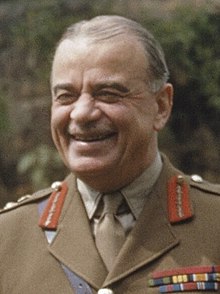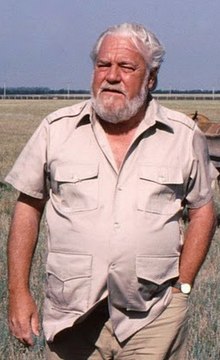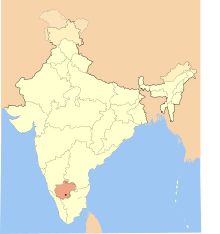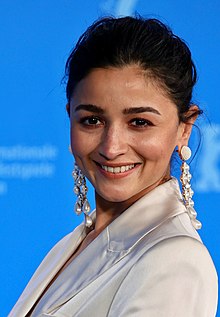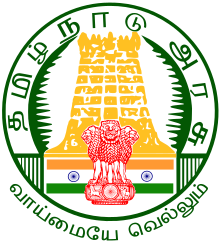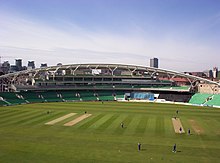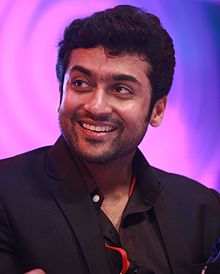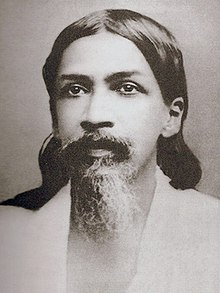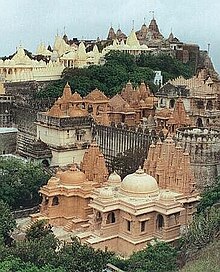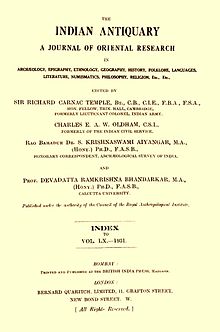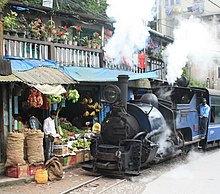Introduction


India, officially the Republic of India, is a country in South Asia. It is the seventh-largest country by area; the most populous country from June 2023 onwards; and since its independence in 1947, the world's most populous democracy. Bounded by the Indian Ocean on the south, the Arabian Sea on the southwest, and the Bay of Bengal on the southeast, it shares land borders with Pakistan to the west; China, Nepal, and Bhutan to the north; and Bangladesh and Myanmar to the east. In the Indian Ocean, India is near Sri Lanka and the Maldives; its Andaman and Nicobar Islands share a maritime border with Thailand, Myanmar, and Indonesia. (Full article...)
 Featured article – show another
Featured article – show another
-
Image 1Dilwale Dulhania Le Jayenge (transl. The Brave-Hearted Will Take the Bride), also known by the initialism DDLJ, is a 1995 Indian Hindi-language musical romance film written and directed by Aditya Chopra in his directorial debut and produced by his father Yash Chopra. Released on 20 October 1995, the film stars Shah Rukh Khan and Kajol as Raj and Simran, two young non-resident Indians, who fall in love during a vacation through Europe with their friends. Raj tries to win over Simran's family so the couple can marry, but Simran's father has long since promised her hand to his friend's son. The film was shot in India, London, and Switzerland, from September 1994 to August 1995.
With an estimated total gross of ₹102.5 crore (today's adjusted gross ₹524 crore), with ₹89 crore (today's adjusted gross ₹455 crore) earned in India and ₹13.50 crore (today's adjusted gross ₹69 crore) in overseas, the film was the highest-grossing Indian film of 1995 and one of the most successful Indian films in history. When adjusted for inflation, it is the second highest-grossing Indian film of the 1990s, behind Hum Aapke Hain Koun..! It won 10 Filmfare Awards—the most for a single film at that time—and the National Film Award for Best Popular Film Providing Wholesome Entertainment. Its soundtrack album became one of the most popular of the 1990s. (Full article...) -
Image 2Sir Robert Eric Mortimer Wheeler CH CIE MC TD FRS FBA FSA (10 September 1890 – 22 July 1976) was a British archaeologist and officer in the British Army. Over the course of his career, he served as Director of both the National Museum of Wales and London Museum, Director-General of the Archaeological Survey of India, and the founder and Honorary Director of the Institute of Archaeology in London, in addition to writing twenty-four books on archaeological subjects.
Born in Glasgow to a middle-class family, Wheeler was raised largely in Yorkshire before moving to London in his teenage years. After studying classics at University College London (UCL), he began working professionally in archaeology, specialising in the Romano-British period. During World War I he volunteered for service in the Royal Artillery, being stationed on the Western Front, where he rose to the rank of major and was awarded the Military Cross. Returning to Britain, he obtained his doctorate from UCL before taking on a position at the National Museum of Wales, first as Keeper of Archaeology and then as Director, during which time he oversaw excavation at the Roman forts of Segontium, Y Gaer, and Isca Augusta with the aid of his first wife, Tessa Wheeler. Influenced by the archaeologist Augustus Pitt Rivers, Wheeler argued that excavation and the recording of stratigraphic context required an increasingly scientific and methodical approach, developing the "Wheeler method". In 1926, he was appointed Keeper of the London Museum; there, he oversaw a reorganisation of the collection, successfully lobbied for increased funding, and began lecturing at UCL. (Full article...) -
Image 3
Vidya Balan (pronounced [ʋɪd̪ːja baːlən]; born 1 January 1979) is an Indian actress. Known for pioneering a change in the portrayal of women in Hindi cinema with her roles in female-led films, she is the recipient of several awards, including a National Film Award and seven Filmfare Awards. She was awarded the Padma Shri by the Government of India in 2014.
Vidya aspired to a career in film from a young age and had her first acting role in the 1995 sitcom Hum Paanch. While pursuing a master's degree in sociology from the University of Mumbai, she made several unsuccessful attempts to start a career in film, and featured in television commercials and music videos. She made her film debut by starring in the Bengali film Bhalo Theko (2003) and received praise for her first Hindi film, the drama Parineeta (2005). This was followed by several commercial successes including Lage Raho Munna Bhai (2006) and Bhool Bhulaiyaa (2007), but her subsequent roles were met with negative reviews. (Full article...) -
Image 4
General Hastings Lionel "Pug" Ismay, 1st Baron Ismay (21 June 1887 – 17 December 1965) was a British politician, diplomat and general in the British Indian Army who was the first secretary general of NATO. He also was Winston Churchill's chief military assistant during the Second World War.
Ismay was born in Nainital, India, in 1887, and educated in the United Kingdom at Charterhouse School and the Royal Military College, Sandhurst. After Sandhurst, he joined the Indian Army as an officer of the 21st Prince Albert Victor's Own Cavalry. During the First World War, he served with the Camel Corps in British Somaliland, where he joined in the British fight against the "Mad Mullah", Mohammed Abdullah Hassan. In 1925, Ismay became an Assistant Secretary of the Committee of Imperial Defence (CID). After being promoted to the rank of colonel, he served as the military secretary for Lord Willingdon, the Viceroy of India, then returned to the CID as Deputy Secretary in 1936. (Full article...) -
Image 5Kal Ho Naa Ho (transl. Tomorrow may never come, pronounced [kəl ɦoː naː ɦoː]), also abbreviated as KHNH, is a 2003 Indian Hindi-language romantic comedy drama film directed by Nikhil Advani in his directorial debut with a story written by Karan Johar with dialogue by Niranjan Iyengar, and produced by Yash Johar. The film stars Shah Rukh Khan, Saif Ali Khan, and Preity Zinta, with Jaya Bachchan, Sushma Seth, Reema Lagoo, Lillete Dubey, and Delnaaz Irani in supporting roles. In the film, Naina Catherine Kapur (Zinta) and Aman Mathur (Shah Rukh Khan) fall in love, but a secret prevents him from reciprocating his feelings and results in a plan to set Naina up with her best friend, Rohit Patel (Saif Ali Khan).
Collaborating with Johar, Shankar–Ehsaan–Loy composed the soundtrack and score. Anil Mehta, Manish Malhotra, and Sharmishta Roy were the cinematographer, costume designer and art director, respectively. Principal photography took place in Toronto, New York City, and Mumbai from January to October 2003. The soundtrack was released on 27 September 2003 to positive reviews; the title song, "It's The Time To Disco", "Kuch To Hua Hai", and "Pretty Woman" were particularly well-received. (Full article...) -
Image 6Sholay (Hindustani: [ˈʃoːleː] ⓘ, transl. 'Embers') is a 1975 Indian Hindi-language action-adventure film directed by Ramesh Sippy, produced by his father G. P. Sippy, and written by Salim–Javed. The film is about two criminals, Veeru (Dharmendra) and Jai (Amitabh Bachchan), hired by a retired police officer (Sanjeev Kumar) to capture the ruthless dacoit Gabbar Singh (Amjad Khan). Hema Malini and Jaya Bhaduri also star, as Veeru and Jai's love interests, Basanti and Radha, respectively. The music was composed by R D Burman.
The film was shot in the rocky terrain of Ramanagara, in the southern state of Karnataka, over a span of two and a half years, beginning in October 1973. After the Central Board of Film Certification mandated the removal of several violent scenes, Sholay was released as a 198-minute long film. In 1990, the original director's cut of 204 minutes became available on home media. When first released, Sholay received negative critical reviews and a tepid commercial response, but favourable word-of-mouth publicity helped it to become a box office success. It broke records for continuous showings in many theatres across India, and ran for more than five years at Mumbai's Minerva theatre. The film was also an overseas success in the Soviet Union. It was the highest-grossing Indian film ever at the time, and was the highest-grossing film in India up until Hum Aapke Hain Koun..! (1994). By numerous accounts, Sholay remains one of the highest-grossing Indian films of all time, adjusted for inflation. (Full article...) -
Image 7The political history of medieval Karnataka spans the 4th to the 16th centuries in Karnataka region of India. The medieval era spans several periods of time from the earliest native kingdoms and imperialism; the successful domination of the Gangetic plains in northern India and rivalry with the empires of Tamilakam over the Vengi region; and the domination of the southern Deccan and consolidation against Muslim invasion. The origins of the rise of the Karnataka region as an independent power date back to the fourth-century birth of the Kadamba Dynasty of Banavasi which was the earliest of the native rulers to conduct administration in the native language of Kannada in addition to the official Sanskrit.
In the southern regions of Karnataka, the Western Gangas of Talakad were contemporaries of the Kadambas. The Kadambas and Gangas were followed by the imperial dynasties of the Badami Chalukya Empire, the Rashtrakuta Empire, the Western Chalukya Empire, the Hoysala Empire and the Vijayanagara Empire, all patronising the ancient Indic religions while showing tolerance to the new cultures arriving from the west of the subcontinent. The Muslim invasion of the Deccan resulted in the breaking away of the feudatory Sultanates in the 14th century. The rule of the Bahamani Sultanate of Bidar and the Bijapur Sultanate from the northern Deccan region caused a mingling of the ancient Hindu traditions with the nascent Islamic culture in the region. The hereditary ruling families and clans ably served the large empires and upheld the local culture and traditions. The fall of the Vijayanagara Empire in 1565 brought about a slow disintegration of Kannada-speaking regions into minor kingdoms that struggled to maintain autonomy in an age dominated by foreigners until unification and independence in 1947. (Full article...) -
Image 8Durrell in Askania Nova, 1985
Gerald Malcolm Durrell OBE (7 January 1925 – 30 January 1995) was a British naturalist, writer, zookeeper, conservationist, and television presenter. He was born in Jamshedpur in British India, and moved to England when his father died in 1928. In 1935 the family moved to Corfu, and stayed there for four years, before the outbreak of World War II forced them to return to the UK. In 1946 he received an inheritance from his father's will that he used to fund animal-collecting trips to the British Cameroons and British Guiana. He married Jacquie Rasen in 1951; they had very little money, and she persuaded him to write an account of his first trip to the Cameroons. The result, titled The Overloaded Ark, sold well, and he began writing accounts of his other trips. An expedition to Argentina and Paraguay followed in 1953, and three years later he published My Family and Other Animals, which became a bestseller.
In the late 1950s Durrell decided to found his own zoo. He finally found a suitable site on the island of Jersey, and leased the property in late 1959. He envisaged the Jersey Zoo as an institution for the study of animals and for captive breeding, rather than a showcase for the public. In 1963 control of the zoo was turned over to the Jersey Wildlife Preservation Trust. The zoo repeatedly came close to bankruptcy over the next few years, and Durrell raised money for it by his writing and by fundraising appeals. To guarantee the zoo's future, Durrell launched a successful appeal in 1970 for funds to purchase the property. (Full article...) -
Image 9

Tripura (/ˈtrɪpʊrə, -ərə/) is a state in northeastern India. The third-smallest state in the country, it covers 10,491 km2 (4,051 sq mi); and the seventh-least populous state with a population of 3.67 million. It is bordered by Assam and Mizoram to the east and by Bangladesh to the north, south and west. Tripura is divided into 8 districts and 23 sub-divisions, where Agartala is the capital and the largest city in the state. Tripura has 19 different tribal communities with a majority Bengali population. Bengali, English and Kokborok are the state's official languages.
The area of modern Tripura — ruled for several centuries by the Manikya Dynasty — was part of the Tripuri Kingdom (also known as Hill Tippera). It became a princely state under the British Raj during its tenure, and acceded to independent India in 1947. It merged with India in 1949 and was designated as a 'Part C State' (union territory). It became a full-fledged state of India in 1972. (Full article...) -
Image 10
Western Ganga was an important ruling dynasty of ancient Karnataka in India which lasted from about 350 to 999 CE. They are known as "Western Gangas" to distinguish them from the Eastern Gangas who in later centuries ruled over Kalinga (modern Odisha and Northern Andhra Pradesh). The general belief is that the Western Gangas began their rule during a time when multiple native clans asserted their freedom due to the weakening of the Pallava empire in South India, a geo-political event sometimes attributed to the southern conquests of Samudra Gupta. The Western Ganga sovereignty lasted from about 350 to 550 CE, initially ruling from Kolar and later, moving their capital to Talakadu on the banks of the Kaveri River in modern Mysore district.
After the rise of the imperial Chalukyas of Badami, the Gangas accepted Chalukya overlordship and fought for the cause of their overlords against the Pallavas of Kanchi. The Chalukyas were replaced by the Rashtrakutas of Manyakheta in 753 CE as the dominant power in the Deccan. After a century of struggle for autonomy, the Western Gangas finally accepted Rashtrakuta overlordship and successfully fought alongside them against their foes, the Chola Dynasty of Tanjavur. In the late 10th century, north of Tungabhadra river, the Rashtrakutas were replaced by the emerging Western Chalukya Empire and the Chola Dynasty saw renewed power south of the Kaveri river. The defeat of the Western Gangas by Cholas around 1000 resulted in the end of the Ganga influence over the region. (Full article...) -
Image 11Bhatt at the 2022 Berlinale
Alia Bhatt (/ˈɑːliə ˈbʌt/; born 15 March 1993) is a British actress of Indian descent who predominantly works in Hindi films. Known for her portrayals of women in challenging circumstances, she has received several accolades, including a National Film Award and six Filmfare Awards. She is one of India's highest-paid actresses. Time awarded her with the Time100 Impact Award in 2022 and named her one of the 100 most influential people in the world in 2024.
Born into the Bhatt family, she is a daughter of filmmaker Mahesh Bhatt and actress Soni Razdan. After making her acting debut as a child in the 1999 thriller film Sangharsh, she played her first leading role in Karan Johar's teen film Student of the Year (2012). She won the Filmfare Critics Award for Best Actress for playing a kidnapping victim in the road drama Highway (2014) and went on to establish herself with starring roles in several romantic films produced by Johar's studio Dharma Productions. (Full article...) -
Image 12
Priyanka Chopra Jonas (pronounced [pɾɪˈjəŋka ˈtʃoːpɽa]; née Chopra; born 18 July 1982) is an Indian actress and producer. The winner of the Miss World 2000 pageant, Chopra is one of India's highest-paid actresses and has received numerous accolades, including two National Film Awards and five Filmfare Awards. In 2016, the Government of India honoured her with the Padma Shri, and Time named her one of the 100 most influential people in the world. In the next two years, Forbes listed her among the World's 100 Most Powerful Women, and in 2022, she was named in the BBC 100 Women list.
Chopra accepted offers to join the Indian film industry following her pageant wins. Her acting debut came in the Tamil film Thamizhan (2002), followed by her first Bollywood feature in The Hero: Love Story of a Spy (2003). She played the leading lady in the box-office hits Andaaz (2003) and Mujhse Shaadi Karogi (2004) and had her breakout role in the 2004 romantic thriller Aitraaz. Chopra established herself with starring roles in the top-grossing productions Krrish and Don (both 2006), and later reprised her role in their sequels. For playing a troubled model in the drama Fashion (2008), Chopra won a National Film Award and a Filmfare Award for Best Actress. Chopra gained further praise for portraying a range of characters in the films Kaminey (2009), 7 Khoon Maaf (2011), Barfi! (2012), Mary Kom (2014), Dil Dhadakne Do (2015), and Bajirao Mastani (2015). (Full article...) -
Image 13The Legend of Bhagat Singh is a 2002 Indian Hindi-language biographical drama film directed by Rajkumar Santoshi. The film is about Bhagat Singh, a revolutionary who fought for Indian independence along with fellow members of the Hindustan Socialist Republican Association. It features Ajay Devgan as the titular character along with Sushant Singh, D. Santosh and Akhilendra Mishra as the other lead characters. Raj Babbar, Farida Jalal and Amrita Rao play supporting roles. The film chronicles Singh's life from his childhood where he witnesses the Jallianwala Bagh massacre until the day he was hanged to death before the official trial dated 24 March 1931.
The film was produced by Kumar and Ramesh Taurani's Tips Industries on a budget of ₹200–250 million (about US$4.2–5.2 million in 2002). The story and dialogue were written by Santoshi and Piyush Mishra respectively, while Anjum Rajabali drafted the screenplay. K. V. Anand, V. N. Mayekar and Nitin Chandrakant Desai were in charge of the cinematography, editing and production design respectively. Principal photography took place in Agra, Manali, Mumbai and Pune from January to May 2002. The soundtrack and film score were composed by A. R. Rahman, with the songs "Mera Rang De Basanti" and "Sarfaroshi Ki Tamanna" being well received in particular. (Full article...) -
Image 14Portrait by Rudolf Swoboda, 1888
Mohammed Abdul Karim (1863 — 20 April 1909), also known as "the Munshi", was an Indian attendant of Queen Victoria. He served her during the final fourteen years of her reign, gaining her maternal affection over that time.
Karim was born the son of a hospital assistant at Lalitpur, near Jhansi in British India. In 1887, the year of Victoria's Golden Jubilee, Karim was one of two Indians selected to become servants to the Queen. Victoria came to like him a great deal and gave him the title of "Munshi" ("clerk" or "teacher"). Victoria appointed him to be her Indian Secretary, showered him with honours, and obtained a land grant for him in India. (Full article...) -
Image 15The frontispiece of the 1920 edition of Tod's Annals and Antiquities of Rajast'han
Lieutenant-Colonel James Tod (20 March 1782 – 18 November 1835) was an officer of the British East India Company and an Oriental scholar. He combined his official role and his amateur interests to create a series of works about the history and geography of India, and in particular the area then known as Rajputana that corresponds to the present day state of Rajasthan, and which Tod referred to as Rajast'han.
Tod was born in London and educated in Scotland. He joined the East India Company as a military officer and travelled to India in 1799 as a cadet in the Bengal Army. He rose quickly in rank, eventually becoming captain of an escort for an envoy in a Sindian royal court. After the Third Anglo-Maratha War, during which Tod was involved in the intelligence department, he was appointed Political Agent for some areas of Rajputana. His task was to help unify the region under the control of the East India Company. During this period Tod conducted most of the research that he would later publish. Tod was initially successful in his official role, but his methods were questioned by other members of the East India Company. Over time, his work was restricted and his areas of oversight were significantly curtailed. In 1823, owing to declining health and reputation, Tod resigned his post as Political Agent and returned to England. (Full article...) -
Image 16

Nyctibatrachus major, the Malabar night frog, large wrinkled frog, or Boulenger's narrow-eyed frog is a species of frog in the family Nyctibatrachidae, commonly known as the robust frogs. It was described in 1882 by the zoologist George Albert Boulenger, and is the type species of the genus Nyctibatrachus. It is a large frog for its genus, with an adult snout–vent length of 31.5–52.0 mm (1.24–2.05 in) for males and 43.7–54.2 mm (1.72–2.13 in) for females. It is mainly brownish to greyish in colour, with a dark greyish-brown upperside, a greyish-white underside, and light grey sides. It also has a variety of grey or brown markings. When preserved in ethanol, it is mostly greyish-brown to grey, with whitish sides. Sexes can be told apart by the presence of the femoral glands (bulbous glands near the inner thigh) in males.
The species is endemic to the Western Ghats mountain range of India, where it is found in Kerala, Tamil Nadu, and Karnataka. Adults inhabit fast-moving forest streams at elevations of up to 900 m (3,000 ft) and have highly specific habitat requirements. Adults are mostly found in or near water and are nocturnal; subadults can be found during both the night and day. Its diet mainly consists of other frogs and insect larvae. Over a period of several days or weeks, females lay multiple small clutches of eggs on leaves and rocks overhanging water; tadpoles drop into the water below on hatching. The species is currently classified as being vulnerable on the IUCN Red List owing to its small and fragmented range and ongoing habitat degradation. Threats to the species include habitat loss, increased human presence near the streams it inhabits, and possibly nitrate pollution caused by fertiliser overuse. (Full article...) -
Image 17Margarita with a Straw is a 2014 Indian Hindi-language drama film directed by Shonali Bose. It stars Kalki Koechlin as an Indian teenager with cerebral palsy who relocates to America for her undergraduate education and comes of age following her complex relationship with a blind girl, played by Sayani Gupta. Revathi, Kuljeet Singh, and William Moseley play supporting roles. Produced by Bose in partnership with Viacom18 Motion Pictures, Margarita with a Straw was co-written by Bose and Nilesh Maniyar. The film deals with the challenging concepts of sexuality, inclusion, self-love, and self-acceptance.
Bose conceived the idea for the film in January 2011 during a conversation with Malini Chib, her cousin and a disability rights activist, about the latter's desire to have a normal sex life. Inspired by Chib's story, Bose wrote the first draft of the film's script. After winning a Sundance Mahindra Global Filmmaker Award for the draft, she modified the script to reflect her own perspective, incorporating several personal experiences into the narrative. Bose completed the screenplay with co-writer Maniyar and the advisory council of the Sundance Institute. (Full article...) -
Image 18

Darjeeling (/dɑːrˈdʒiːlɪŋ/, Nepali: [ˈdard͡ziliŋ], Bengali: [ˈdarˌdʒiliŋ]) is a city in the northernmost region of the Indian state of West Bengal. Located in the Eastern Himalayas, it has an average elevation of 2,045 metres (6,709 ft). To the west of Darjeeling lies the easternmost province of Nepal, to the east the Kingdom of Bhutan, to the north the Indian state of Sikkim, and farther north the Tibet Autonomous Region region of China. Bangladesh lies to the south and southeast, and most of the state of West Bengal lies to the south and southwest, connected to the Darjeeling region by a narrow tract. Kangchenjunga, the world's third-highest mountain, rises to the north and is prominently visible on clear days.
In the early 19th century, during East India Company rule in India, Darjeeling was identified as a potential summer retreat for British officials, soldiers and their families. The narrow mountain ridge was leased from the Kingdom of Sikkim, and eventually annexed to British India. Experimentation with growing tea on the slopes below Darjeeling was highly successful. Thousands of labourers were recruited chiefly from Nepal to clear the forests, build European-style cottages and work in the tea plantations. The widespread deforestation displaced the indigenous peoples. Residential schools were established in and around Darjeeling for the education of children of the domiciled British in India. By the late-19th century, a novel narrow-gauge mountain railway, the Darjeeling Himalayan Railway, was bringing summer residents into the town and carrying a freight of tea out for export to the world. After India's independence in 1947, as the British left Darjeeling, its cottages were purchased by wealthy Indians from the plains and its tea plantations by out-of-town Indian business owners and conglomerates. (Full article...) -
Image 19
Kalki Koechlin (/ˈkʌlki kɛˈklæ̃/ ⓘ; born 10 January 1984) is a French actress and writer who works in films and stage. Known for her unconventional body of work, particularly in Hindi films, she is the recipient of several accolades, including a National Film Award and a Filmfare Award. Although a French citizen, she has been raised and lived most of her life in India.
Born in Pondicherry, India, Koechlin was drawn to theatre from a young age. She studied drama at Goldsmiths, University of London, and worked simultaneously with a local theatre company. After returning to India, she made her Hindi film debut as Chanda in the black comedy-drama Dev.D. (2009), winning the Filmfare Award for Best Supporting Actress. She subsequently starred in two of the highest-grossing Hindi films of their respective years, the comedy-dramas Zindagi Na Milegi Dobara (2011) and Yeh Jawaani Hai Deewani (2013), both of which garnered her nominations for the Filmfare Award for Best Supporting Actress. Koechlin also starred in and co-wrote the crime thriller That Girl in Yellow Boots (2011). (Full article...) -
Image 20

The Kingdom of Mysore was a geopolitical realm in southern India founded in around 1399 in the vicinity of the modern-day city of Mysore and prevailed until 1950. The territorial boundaries and the form of government transmuted substantially throughout the kingdom's lifetime. While originally a feudal vassal under the Vijayanagara Empire, it became a princely state in British Raj from 1799 to 1947, marked in-between by major political changes.
The kingdom, which was founded and ruled for the most part by the Wadiyars, initially served as a feudal vassal under the Vijayanagara Empire. With the gradual decline of the Empire, the 16th-century Timmaraja Wodeyar II declared independence from it. The 17th century saw a steady expansion of its territory and, during the rules of Narasaraja Wodeyar I and Devaraja Wodeyar II, the kingdom annexed large expanses of what is now southern Karnataka and parts of Tamil Nadu, becoming a formidable power in the Deccan. (Full article...) -
Image 21A Bengal tigress in Kanha Tiger Reserve, India
The tiger (Panthera tigris) is a large cat and a member of the genus Panthera native to Asia. It has a powerful, muscular body with a large head and paws, a long tail and orange fur with black, mostly vertical stripes. It is traditionally classified into nine recent subspecies, though some recognise only two subspecies, mainland Asian tigers and the island tigers of the Sunda Islands.
Throughout the tiger's range, it inhabits mainly forests, from coniferous and temperate broadleaf and mixed forests in the Russian Far East and Northeast China to tropical and subtropical moist broadleaf forests on the Indian subcontinent and Southeast Asia. The tiger is an apex predator and preys mainly on ungulates, which it takes by ambush. It lives a mostly solitary life and occupies home ranges, defending these from individuals of the same sex. The range of a male tiger overlaps with that of multiple females with whom he mates. Females give birth to usually two or three cubs that stay with their mother for about two years. When becoming independent, they leave their mother's home range and establish their own. (Full article...) -
Image 22Padukone at the 2018 Cannes Film Festival
Deepika Padukone (pronounced [d̪iːpɪkaː pəɖʊkoːɳeː]; born 5 January 1986) is an Indian actress who works predominantly in Hindi films. She is India's highest-paid actress, as of 2023, and her accolades include three Filmfare Awards. Time named her one of the 100 most influential people in the world in 2018 and awarded her the Time100 Impact Award in 2022.
Padukone, the daughter of the badminton player Prakash Padukone, was born in Copenhagen and raised in Bangalore. As a teenager, she played badminton in national level championships but left her career in the sport to become a fashion model. She soon received offers for film roles and made her acting debut in 2006 as the title character of the Kannada film Aishwarya. Padukone then played a dual role opposite Shah Rukh Khan in her first Bollywood release, the romance Om Shanti Om (2007), which won her the Filmfare Award for Best Female Debut. Padukone received praise for her starring role in the romance Love Aaj Kal (2009), but this was followed by a brief setback. (Full article...) -
Image 23Parinda (transl. Bird) is a 1989 Indian Hindi-language crime thriller film directed, produced and distributed by Vidhu Vinod Chopra. The film stars Jackie Shroff, Anil Kapoor, Nana Patekar and Madhuri Dixit. The story and scenario were written by Chopra, while Shiv Kumar Subramaniam and Imtiyaz Husain wrote the screenplay and dialogues, respectively. R. D. Burman composed the music and Khurshid Hallauri wrote the lyrics. Binod Pradhan served as the film's cinematographer and Renu Saluja was its editor.
Parinda follows Kishan (Shroff), who works for the underworld chieftain Anna (Patekar). Kishan's brother Karan (Kapoor) returns home after completing his studies in the United States. The two brothers are caught on different sides of a gang war after Karan decides to avenge his friend's death by Anna. (Full article...) -
Image 24
Kareena Kapoor Khan (pronounced [kəˈriːna kəˈpuːr xɑːn]; née Kapoor; born 21 September 1980) is an Indian actress. A prolific leading lady of Hindi cinema since 2000, she is noted for her roles in a range of film genres—from romantic comedies to crime dramas. Kapoor is the recipient of several awards, including six Filmfare Awards, and as of 2024, is one of Hindi cinema's highest-paid actresses.
Born into the Kapoor family, she is the daughter of actors Babita and Randhir Kapoor, and the younger sister of actress Karisma Kapoor. After making her acting debut in 2000 in Refugee, Kapoor established herself the following year with several roles, including in the top-grossing drama Kabhi Khushi Kabhie Gham.... This was followed by a series of commercial failures and negative reviews for her repetitive roles. An against-type performance as a sex worker in the 2004 drama Chameli marked a turning point in her career. She earned critical recognition for her portrayal of a riot victim in the 2004 drama Dev and a character based on Desdemona in the 2006 crime film Omkara. Her performance as a loquacious woman in the romantic comedy Jab We Met (2007) earned her the Filmfare Award for Best Actress. (Full article...) -
Image 25
Typhoon Gay, also known as the Kavali Cyclone of 1989, was a small but powerful tropical cyclone which caused more than 800 fatalities in and around the Gulf of Thailand in November 1989. The worst typhoon to affect the Malay Peninsula in thirty-five years, Gay originated from a monsoon trough over the Gulf of Thailand in early November. Owing to favorable atmospheric conditions, the storm rapidly intensified, attaining winds over 120 km/h (75 mph) by 3 November. Later that day, Gay became the first typhoon since 1891 to make landfall in Thailand, striking Chumphon Province with winds of 185 km/h (115 mph). The small storm emerged into the Bay of Bengal and gradually reorganized over the following days as it approached southeastern India. On 8 November, Gay attained its peak intensity as a Category 5-equivalent cyclone with winds of 260 km/h (160 mph). The cyclone then moved ashore near Kavali, Andhra Pradesh. Rapid weakening ensued inland, and Gay dissipated over Maharashtra early on 10 November.
The typhoon's rapid development took hundreds of vessels by surprise, leading to 275 offshore fatalities. Of these, 91 occurred after an oil drilling ship, the Seacrest, capsized amid 6–11 m (20–36 ft) swells. Across the Malay Peninsula, 588 people died from various storm-related incidents. Several towns in coastal Chumphon were destroyed. Losses throughout Thailand totaled ฿11 billion (US $497 million). Striking India as a powerful cyclone, Gay damaged or destroyed about 20,000 homes in Andhra Pradesh, leaving 100,000 people homeless. In that country, 69 deaths and ₹410 million (US $25.3 million) in damage were attributed to Gay. (Full article...)
Selected pictures
-
Image 1Photograph: Muhammad Mahdi KarimAlstroemeria × hybrida, an Alstroemeria hybrid, at the Lal Bagh Botanical Gardens in Bangalore, India. The genus consists of some 120 species and is native to South America.
-
Image 2Photograph: Muhammad Mahdi KarimThe Bara Imambara is an imambara complex in Lucknow, India. Built by Asaf-ud-Daula, Nawab of Awadh, in 1785, the building reflects a maturation of ornamented Mughal design (as seen in the Badshahi Mosque).
-
Image 3Photograph: JJ HarrisonThe Siberian rubythroat (Luscinia calliope) is a small passerine bird generally considered to be an Old World flycatcher of the family Muscicapidae. This migratory insectivorous species breeds in mixed coniferous forest with undergrowth in Siberia, where it nests near the ground. It winters in Thailand, India and Indonesia. It is an extremely rare vagrant to Western Europe and the Aleutian Islands.
-
Image 4A statue of the Hindu god Shiva as Nataraja, the Lord of Dance. In this form, Shiva performs his divine dance to destroy a weary universe and make preparations for the god Brahma to start the process of creation. A Telugu and Tamil concept, Shiva was first depicted as Nataraja in the famous Chola bronzes and sculptures of Chidambaram. The form is present in most Shiva temples in South India, and is the main deity in Chidambaram Temple, the foremost Shaivist temple.
-
Image 5Photograph credit: Charles James SharpThe pied bush chat (Saxicola caprata) is a small passerine bird widely distributed in Asia. The males are black with white shoulder and vent patches, while the females are predominantly brownish. This species is insectivorous, and like other chats hunts from a prominent low perch. This female pied bush chat was photographed in Pench National Park, India.
-
Image 6Photo credit: Dan BradyPigments for sale at a market stall in Goa, India. Many pigments used in manufacturing and the visual arts are dry colourants, ground into a fine powder. This powder is then added to a vehicle or matrix, a relatively neutral or colorless material that acts as a binder, before it is applied. Unlike a dye, a pigment generally is insoluble.
-
Image 7Photo credit: PeripitusThe national flower of India, Nelumbo nucifera is known by a number of common names, including Indian lotus, sacred lotus, bean of India, and sacred water-lily. This plant is an aquatic perennial, though under favorable conditions its seeds may remain viable for many years.
-
Image 8Photograph: Augustus BinuOdissi is an ancient classical dance that originated in the Hindu temples of Odisha, India. Historically, it has been performed predominantly by women, and expressed religious stories and spiritual ideas, particularly of Vaishnavism (Vishnu as Jagannath), but also of other traditions such as those related to Hindu gods Shiva and Surya, as well as Hindu goddesses (Shaktism). Modern Odissi productions by Indian artists have presented a diverse range of experimental ideas, culture fusion, themes and plays.
Odissi is learnt and performed as a composite of a basic dance motif called the Bhangas (symmetric body bends, stance). It involves the lower, mid, and upper body as three sources of perfecting expression and audience engagement with geometric symmetry and rhythmic musical resonance. -
Image 9Photograph credit: Rucha Karkarey; edited by John HarrisonThe round ribbontail ray (Taeniura meyeni) is a species of stingray in the family Dasyatidae, found throughout the nearshore waters of the tropical Indo-Pacific region. Reaching 1.8 m (6 ft) across, this large ray is characterized by a thick, rounded pectoral fin disc covered by small tubercles on top, and a relatively short tail bearing a single venomous spine. The ray is well-camouflaged when lying on the seabed; it is largely nocturnal, and preys on molluscs, crustaceans and bony fish. Mature females bear litters of up to seven pups, which are fed during gestation on "uterine milk", a product secreted by the walls of the oviduct. This round ribbontail ray was photographed in Lakshadweep, India.
-
Image 10
 Coin design credit: East India Company and the Calcutta Mint; photographed by Andrew ShivaThe mohur is a gold coin that was formerly minted by several governments, including those of British India. It was usually equivalent in value to fifteen silver rupees. Gold mohurs issued by the British East India Company or the Crown are valuable collectors' items, and sell in auctions for high prices. The double mohur (minted between 1835 and 1918), with a value of thirty rupees, is the highest-denomination circulating coin ever issued in India. The 1835 two-mohur coin above was minted in the reign of King William IV, while the 1862 one-mohur coin below was minted in the reign of Queen Victoria; both are now part of the National Numismatic Collection at the National Museum of American History.
Coin design credit: East India Company and the Calcutta Mint; photographed by Andrew ShivaThe mohur is a gold coin that was formerly minted by several governments, including those of British India. It was usually equivalent in value to fifteen silver rupees. Gold mohurs issued by the British East India Company or the Crown are valuable collectors' items, and sell in auctions for high prices. The double mohur (minted between 1835 and 1918), with a value of thirty rupees, is the highest-denomination circulating coin ever issued in India. The 1835 two-mohur coin above was minted in the reign of King William IV, while the 1862 one-mohur coin below was minted in the reign of Queen Victoria; both are now part of the National Numismatic Collection at the National Museum of American History. -
Image 11Bangalore Town Hall is a neoclassical municipal building in Bangalore, India. It is sometimes known, after a former president of Bangalore, as the Sir K. P. Puttanna Chetty Town Hall. Built by Mirza Ismail in 1935, it underwent renovations in 1990 at a cost of ₹6.5 million (US$371,400 at the time).
-
Image 12Photograph credit: Charles J. SharpThe Indian roller (Coracias benghalensis) is a member of the bird family Coraciidae, the rollers. It occurs widely from the Arabian Peninsula to the Indian subcontinent and is designated as Least Concern on the IUCN Red List. The bird is best known for the aerobatic displays of males during the breeding season. It is commonly found in open grassland and scrub forest habitats, and is often seen perched on roadside bare trees and wires, which give it a good view of the ground below where it finds its prey. Its diet consists mainly of insects such as beetles and grasshoppers, but also includes spiders, scorpions, amphibians and small reptiles. The largest population occurs in India, and several states in India have chosen it as their state bird.
This picture shows an Indian roller of the benghalensis subspecies, photographed in Kanha Tiger Reserve in the Indian state of Madhya Pradesh. -
Image 13Photograph credit: Jeevan JosePapilio polymnestor, the blue Mormon, is a species of swallowtail butterfly found in southern India and Sri Lanka. It is a woodland species, often seen on forest paths and near streams. The larvae feed on trees in the family Rutaceae, such as citrus. Young larvae are green with white markings and position themselves on the upper surface of leaves, relying on their cryptic colouring, which resembles bird droppings, for protection. Older larvae seek less conspicuous locations, and have a unique habit of securing their balance by weaving silk on the substratum. This adult male P. polymnestor butterfly was photographed in the Indian state of Kerala.
-
Image 14Photograph: Yann; edit: Jim CarterA view of the Taj Mahal from the south, featuring the Charbagh garden. The mausoleum complex also includes subsidiary tombs, waterworks infrastructure, the small town of Taj Ganji, and a "moonlight garden". Its origins and architecture have been extensively documented, covering both the circumstances of its commission and the cultural and historical influence of the Islamic Mughal Empire in India.
-
Image 15Papilio demoleus matingPhotograph: JkadavoorA mating pair of Papilio demoleus, a common and widespread Swallowtail butterfly, photographed at Kadavoor, Kerala, India. After successful mating the female goes from plant to plant, laying a single egg at a time on top of a leaf, and flies off as soon as the egg is laid.
 Featured list – show another
Featured list – show another
-
Image 1

Priyanka Chopra's performance in Mary Kom garnered her several awards and nominations
Mary Kom is a 2014 Indian biographical sports drama film directed by Omung Kumar and produced by Sanjay Leela Bhansali and Viacom 18 Motion Pictures. The film features Priyanka Chopra in the lead role as the boxer Mary Kom, with Darshan Kumar and Sunil Thapa in supporting roles as her husband and mentor, Onler Kom and M. Narjit Singh respectively. The film was written by Saiwyn Quadras, with the cinematography provided by Keiko Nakahara while Bhansali co-edited the film with Rajesh G. Pandey. The film follows Kom's journey of becoming a boxer to her victory at the 2008 World Boxing Championships in Ningbo, China.
Before its theatrical release on 5 September 2014, the film premiered at the 2014 Toronto International Film Festival, where it became the first Hindi film to be screened on the opening night of the film festival. The film received generally positive reviews from critics and was a commercial success. It grossed ₹1.05 billion (US$12 million) at the box-office against a budget of ₹150 million (US$1.7 million). Mary Kom has received various awards and nominations, with praise for its direction, Chopra's performance, screenplay, editing, background score, and costume design. As of August 2015, the film has won 20 awards. (Full article...) -
Image 2

Barfi! is a 2012 Indian romantic comedy-drama film written and directed by Anurag Basu and produced by UTV Motion Pictures. The film features Ranbir Kapoor, Priyanka Chopra, and Ileana D'Cruz in the lead roles, with Saurabh Shukla, Ashish Vidyarthi, and Roopa Ganguly playing supporting roles. The screenplay which incorporates a nonlinear narrative was co-written by Basu with his wife Tani. Pritam Chakraborty composed the musical and background score while Akiv Ali edited the film, with the cinematography provided by Ravi Varman. Set between 1972 and 2012, the film narrates the story of the title character from Darjeeling and his relationships with two women, Shruti and the autistic Jhilmil.
Made on a budget of approximately ₹410 million (US$4.7 million), Barfi! opened worldwide on 14 September 2012 to widespread critical acclaim. It was a major commercial success, grossing ₹1.88 billion (US$22 million) at the box office. Barfi! has received various awards and nominations, with praise for its direction, the cast's performances, cinematography, screenplay, musical score, costume and production design. As of June 2015, the film has won 70 awards. (Full article...) -
Image 3The 2022 recipient: Rishab Shetty
The National Film Award for Best Actor in a Leading Role is an honour presented annually at the National Film Awards of India instituted since 1967 to actors who have delivered the best performance in a leading role within the Indian film industry. Called the "State Awards for Films" when established in 1954, the National Film Awards ceremony is older than the Directorate of Film Festivals. The State Awards instituted the individual award in 1968 as the "Bharat Award for the Best Actor"; in 1975, it was renamed as the "Rajat Kamal Award for the Best Actor". Throughout the past 45 years, accounting for ties and repeat winners, the Government of India has presented a total of 52 "Best Actor" awards to 40 actors. Until 1974, winners of the National Film Award received a figurine and certificate; since 1975, they have been awarded with a "Rajat Kamal" (silver lotus), certificate and a cash prize. Since the 70th National Film Awards, the name was changed to "National Film Award for Best Actor in a Leading Role".
Although the Indian film industry produces films in around 20 languages and dialects, the actors whose performances have won awards have worked in eight major languages: Hindi (twenty-five awards), Malayalam (fourteen awards), Tamil (nine awards), Bengali (five awards), Marathi, Kannada (four awards), English (two awards), and Telugu (one award). (Full article...) -
Image 4The Pampa Award (or Pampa Prashasti) is a literary award in the Indian state of Karnataka. The award was established in 1987 by the government of Karnataka. It is the highest literary honor conferred by the Department of Kannada and Culture, Government of Karnataka State, and recognises works written in the Kannada language (1 of the 22 official languages of India).
The award is named after the first Kannada poet Adikavi Pampa. The award originally comprised a cash prize of ₹1 lakh (US$1,200), a shawl, a citation and a memento. The cash prize was increased to ₹3 lakh (US$3,500) in 2008. Prior to 1996, the awards were given for a best single work by a Kannada writer. Since then, the award has been given to writers for their lifetime contribution to the Kannada literature. The Pampa Prashasti is presented by the Chief Minister, during the Kadambotsava, a cultural festival held annually in Pampa's hometown of Banavasi in Uttara Kannada district. (Full article...) -
Image 5Mikoyan MiG-29K in flight over Indian islands
The Indian Navy currently operates twenty-five air squadrons. Of these, eleven operate fixed-wing aircraft, ten are helicopter squadrons and the remaining three are equipped with unmanned aerial vehicles (UAV). Building on the legacy inherited from the Royal Navy prior to Indian independence, the concept of naval aviation in India started with the establishment of Directorate of Naval Aviation at Naval Headquarters (NHQ) in early 1948. Later that year officers and sailors from the Indian Navy were sent to Britain for pilot training. In 1951, the Fleet Requirement Unit (FRU) was formed to meet the aviation requirements of the navy. On 1 January 1953, the charge of Cochin airfield was handed over to the navy from the Directorate General of Civil Aviation. On 11 March, the FRU was commissioned at Cochin with ten newly acquired Sealand aircraft. The navy's first air station, INS Garuda, was commissioned two months later. From February 1955 to December 1958, ten Firefly aircraft were acquired. To meet the training requirements of the pilots, the indigenously developed HAL HT-2 trainer was inducted into the FRU. On 17 January 1959, the FRU was commissioned as Indian Naval Air Squadron (INAS) 550, to be the first Indian naval air squadron. In the following two years, three more naval air squadrons—INAS 300, INAS 310 and INAS 551—were commissioned. The first two operated from the newly purchased aircraft carrier INS Vikrant flying Sea Hawks and Alizés, whereas the latter one, equipped with Vampires, was used for training purposes.
Between 1961 and 1971, three helicopter squadrons were commissioned—INAS 321, INAS 330 and INAS 561. The first two were equipped with HAL Chetak and Sea King 42Bs for search and rescue and anti-submarine roles respectively, whereas the later one assumed a training role. In December 1971, the squadrons embarked on the aircraft carrier INS Vikrant saw action in the 1971 Indo-Pakistani War. Between 1976 and 1977, INAS 312 and INAS 315 were commissioned with Super Constellation and Ilyushin Il-38s respectively. In December 1980, another helicopter squadron intended for anti-submarine warfare—INAS 333—was commissioned. It was initially equipped with Ka-25s, and with Ka-28s in late 1980s. In 1984, one patrol and one helicopter squadron—INAS 318 and INAS 336—were commissioned. The patrol squadron was initially equipped with Islander aircraft, but they were replaced by Dornier 228s in 2000. In November 1990, another Sea King squadron—INAS 339—was commissioned. Later in 1993, the Sea Kings were replaced by Ka-28s, and in 2003, Ka-31s were inducted, making it the only Indian naval air squadron for the role of airborne early warning and control. (Full article...) -
Image 6

The Padma Bhushan is the third-highest civilian award of the Republic of India. Instituted on 2 January 1954, the award is given for "distinguished service of a high order", without distinction of race, occupation, position, or sex. The recipients receive a Sanad, a certificate signed by the President of India and a circular-shaped medallion with no monetary association. The recipients are announced every year on Republic Day (26 January) and registered in The Gazette of India—a publication used for official government notices and released weekly by the Department of Publication, under the Ministry of Urban Development. The conferral of the award is not considered official without its publication in the Gazette. The name of recipient, whose award have been revoked or restored, both of which require the authority of the President, is archived and they are required to surrender their medal when their name is struck from the register; none of the conferments of Padma Bhushan during 1980–1989 have been revoked or restored. The recommendations are received from all the state and the union territory governments, as well as from Ministries of the Government of India, the Bharat Ratna and the Padma Vibhushan awardees, the Institutes of Excellence, the Ministers, the Chief Ministers and the Governors of State, and the Members of Parliament including private individuals.
When instituted in 1954, the Padma Bhushan was classified as "Dusra Varg" (Class II) under the three-tier Padma Vibhushan awards, which were preceded by the Bharat Ratna in hierarchy. On 15 January 1955, the Padma Vibhushan was reclassified into three different awards as the Padma Vibhushan, the Padma Bhushan and the Padma Shri. The criteria included "distinguished service of a high order in any field including service rendered by Government servants", but excluded those working with the public sector undertakings with the exception of doctors and scientists. The 1954 statutes did not allow posthumous awards; this was subsequently modified in the January 1955 statute. The design was also changed to the form that is currently in use; it portrays a circular-shaped toned bronze medallion 1+3⁄4 inches (44 mm) in diameter and 1⁄8 inch (3.2 mm) thick. The centrally placed pattern made of outer lines of a square of 1+3⁄16 inches (30 mm) side is embossed with a knob carved within each of the outer angles of the pattern. A raised circular space of diameter 1+1⁄16 inches (27 mm) is placed at the centre of the decoration. A centrally located lotus flower is embossed on the obverse side of the medal and the text "Padma" is placed above and the text "Bhushan" is placed below the lotus written in Devanagari script. The State Emblem of India is displayed in the centre of the reverse side, together with the national motto of India, "Satyameva Jayate" (Truth alone triumphs) in Devanagari script, which is inscribed on the lower edge. The rim, the edges and all embossing on either side is of standard gold with the text "Padma Bhushan" of gold gilt. The medal is suspended by a pink riband 1+1⁄4 inches (32 mm) in width with a broad white stripe in the middle. It is ranked fifth in the order of precedence of wearing of medals and decorations of the Indian civilian and military awards. (Full article...) -
Image 7

Priyanka Chopra won several awards, including the National and Filmfare awards for Best Actress for her performance in Fashion
Fashion is a 2008 Indian drama film directed by Madhur Bhandarkar and produced by UTV Motion Pictures. The film features Priyanka Chopra in the lead role, with Kangana Ranaut, Mugdha Godse, Arbaaz Khan and Arjan Bajwa in supporting roles as well as several professional fashion models playing themselves. Bhandarkar co-wrote the film with Ajay Monga and Anuraadha Tewari. Deven Murdeshwar edited the film while the cinematography was provided by Mahesh Limaye. Salim–Sulaiman composed the musical score, with lyrics written by Irfan Siddiqui and Sandeep Nath. The film focuses on the transformation of Meghna Mathur, an aspiring fashion model played by Chopra, from a small-town girl to a supermodel in the Indian fashion industry.
Produced on a budget of ₹180 million (US$2.1 million), Fashion was released on 29 October 2008 to critical acclaim and box-office success. It grossed ₹600 million (US$6.9 million) and was noted for being commercially successful despite being a women-centric film with no male lead. Fashion received various awards and nominations, with praise for its direction, the performance of the cast, screenplay, editing, musical score, and costume design. (Full article...) -
Image 8The Dirty Picture is a 2011 Indian biographical drama film directed by Milan Luthria and produced by Shobha and Ekta Kapoor. Inspired by the lives of such actresses as Silk Smitha and Disco Shanti, the film narrates the rise and fall of a dancing girl in Tamil cinema. The Dirty Picture features Vidya Balan in the lead role, and co-stars Emraan Hashmi, Tusshar Kapoor and Naseeruddin Shah. Rajat Arora wrote the screenplay, dialogues and lyrics for the film and Vishal–Shekhar composed the music.
Made on a budget between ₹170 million (US$2.0 million) and ₹180 million (US$2.1 million), The Dirty Picture was released worldwide on 2 December 2011, and earned ₹1.14 billion (US$13 million). The film garnered awards and nominations in several categories, with particular praise for Vidya's performance, the dialogues, and the costume design by Niharika Khan. As of 2012, the film has won 51 awards. (Full article...) -
Image 9
The chief minister of Tamil Nadu is the chief executive of the Indian state of Tamil Nadu. In accordance with the Constitution of India, the governor is a state's de jure head, but de facto executive authority rests with the chief minister. Following elections to the Tamil Nadu Legislative Assembly, the state's governor usually invites the party (or coalition) with a majority of seats to form the government. The governor appoints the chief minister, whose council of ministers are collectively responsible to the assembly. Given that he has the confidence of the assembly, the chief minister's term is for five years and is subject to no term limits.
Since 1952, Tamil Nadu has had 12 chief ministers, 13 including V. R. Nedunchezhiyan, who twice acted in the role. The longest-serving chief minister, M. Karunanidhi from Dravida Munnetra Kazhagam held the office for over eighteen years in multiple tenures, while he was the one who had the largest gap between two terms (nearly thirteen years). The All India Anna Dravida Munnetra Kazhagam's former general secretary J. Jayalalithaa has the second-longest tenure, and its founder M. G. Ramachandran, the first actor to become the chief minister in India has the third-longest tenure, while his wife V. N. Janaki Ramachandran has the shortest tenure (only 23 days). K. Kamaraj resigned his post of his own free will and devoted all of his energy to the revitalization of the Indian National Congress party; he was responsible for the elevation of Lal Bahadur Shastri to the position of Prime Minister of the Republic of India following the death of Jawaharlal Nehru and of Indira Gandhi following the death of Lal Bahadur Shastri. C. Rajagopalachari served as the last Governor-General of the Union of India before becoming chief minister of undivided Madras State. There have been four instances of president's rule in Tamil Nadu, most recently in 1991. (Full article...) -
Image 10
Chandrasekhar's six wickets for 38 runs at the Kennington Oval was influential in setting up India's first ever series victory in England.
B. S. Chandrasekhar is a former international cricketer who represented the Indian cricket team between 1964 and 1979. In cricket, a five-wicket haul refers to a bowler taking five or more wickets in a single innings. This is regarded as a notable achievement, and as of October 2024, only 54 bowlers have taken 15 or more five-wicket hauls at international level in their cricketing careers. Chandrasekhar played as a leg spin bowler who formed a part of the Indian spin quartet. Described by West Indies cricketer Viv Richards as the "most difficult" bowler, Chandrasekhar took 16 five-wicket hauls during his international career. He developed an interest in the game when he was a child, watching the playing styles of Australian leg spinner Richie Benaud. Chandrasekhar was affected by polio at the age of five which weakened his right arm. He started as a left-arm bowler but gradually shifted to his withered right arm as it could offer more spin.
Chandrasekhar made his Test debut in 1964 against England at the Brabourne Stadium, claiming four wickets for 67 runs in the first innings. His first five-wicket haul came against West Indies two years later at the same venue. Chandrasekhar's bowling figures of six wickets for 38 runs in 1971 were instrumental in setting up India's first victory in England. It was noted as the Indian "Bowling Performance of the Century" by Wisden in 2002. His bowling performances in the previous English season led to him being named one of the five Wisden Cricketers of the Year in 1972. His career-best figures for an innings were eight wickets for 79 runs against England at the Feroz Shah Kotla Ground in December 1972. Chandrasekhar took a pair of five-wicket hauls for the only time in his career when he took 12 wickets for 104 runs against Australia at the Melbourne Cricket Ground; the performance was effective in ensuring India's first victory in Australia. In Tests, he was most successful against England taking eight fifers. (Full article...) -
Image 11
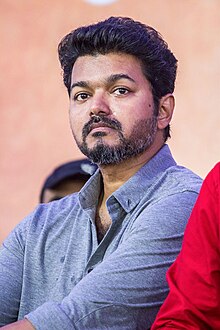
Vijay in 2018 in Nadigar Sangam Protest
Vijay is an Indian actor, playback singer and politician who works in Tamil cinema. He made his cinematic debut in 1984 with Vetri, directed by his father, S. A. Chandrasekhar. After appearing in Chandrasekhar's films as a child artist, Vijay made his debut as a lead actor with Naalaiya Theerpu (1992) at the age of 18. He followed it with a role opposite Vijayakanth in Senthoorapandi (1993). Vijay went on to play lead roles in his father's directorial ventures such as Rasigan (1994) and Deva (1995) and Vishnu (1995). Most of those films were successful commercially.
Vijay's first commercial blockbuster was romcom Coimbatore Mappillai in 1996, followed by his breakthrough blockbuster romance film, Poove Unakkaga. His subsequent films, Love Today (1997) and Kadhalukku Mariyadhai (1997), were critically and commercially successful. His performance in the latter won him the Tamil Nadu State Film Award for Best Actor. Thulladha Manamum Thullum (1999), where he played a passionate singer gained him the reputation of a romantic hero. (Full article...) -
Image 12

Dil Dhadakne Do (transl. Let the Heart Beat) is a 2015 Indian comedy-drama film directed by Zoya Akhtar. Produced by Ritesh Sidhwani and Farhan Akhtar, the film features an ensemble cast consisting of Anil Kapoor, Shefali Shah, Priyanka Chopra, Ranveer Singh, Anushka Sharma and Farhan Akhtar. The supporting cast also includes Rahul Bose, Zarina Wahab, Vikrant Massey, Ridhima Sud, Pawan Chopra, Parmeet Sethi, Dolly Mattdo and Manoj Pahwa. Akhtar co-wrote the screenplay with her friend and longtime collaborator Reema Kagti. The soundtrack was composed by the trio Shankar–Ehsaan–Loy while the cinematography was provided by Carlos Catalan. Anand Subaya and Manan Mehta edited the film.
The film tells the story of the Mehras, a dysfunctional Punjabi family who invite their family and friends along on a cruise trip to celebrate the parents' 30th wedding anniversary. Dil Dhadakne Do was released worldwide on 5 June 2015 to positive reviews from critics. The film grossed ₹1.45 billion at global box office on a budget of ₹580 million. The film garnered awards and nominations in a variety of categories with particular praise for Akhtar's direction, the performances, the music and costume design. (Full article...) -
Image 13
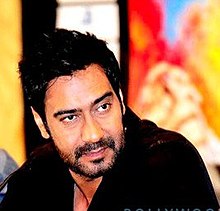
Devgn at an event for his film Drishyam in 2015
Ajay Devgn is an Indian actor, director and producer who works in Hindi films. He debuted as an actor in Phool Aur Kaante (1991), which won him the Filmfare Award for Best Male Debut. Devgn then played a kickboxer in the martial arts film Jigar (1992) and a blind in Vijaypath (1994) and starred in Suhaag (1994), Dilwale (1994), Diljale (1996), Jaan (1996), Ishq (1997), Pyaar To Hona Hi Tha (1998), and Hum Dil De Chuke Sanam (1999). He garnered Filmfare Best Actor nominations for Naajayaz and Hum Dil De Chuke Sanam and also won his first National Film Award for Best Actor for his performance in Zakhm (1998). In 2000, Devgn started Ajay Devgn FFilms, producing and headlining the commercially unsuccessful Raju Chacha. He received a Filmfare Best Supporting Actor nomination for enacting a dacoit in the ensemble film Lajja (2001).
2002 proved to be a banner year for Devgn as he received universal acclaim for his performances in Company, The Legend of Bhagat Singh and Deewangee. He won his second National Award for portraying revolutionary Bhagat Singh in The Legend of Bhagat Singh and the Filmfare Critics Award for Best Actor for it and Company, along with a Filmfare Best Villain Award for Deewangee. In 2003, he acted in the Bhoot, a sleeper hit, and played a police officer in Gangaajal, which earned him another Filmfare Best Actor nomination. He was next featured in Yuva (2004), Kaal (2005), and Omkara (2006). Rohit Shetty's Golmaal series established Devgn in comic roles, producing Golmaal (2006), Golmaal Returns (2008) and Golmaal 3 (2010). However Devgn was highly panned for Aag (2007), based on the 1975 cult classic Sholay. Today, it is considered one of the worst films. In 2008, he made his directorial debut with his own production U Me Aur Hum. 2010 proved to be a milestone year for him as he delivered his first 100 Crore Club film with Golmaal 3 and received positive feedback for the top-grossing films Raajneeti and Once Upon a Time in Mumbaai. The latter fetched him a Filmfare Best Actor nomination, as like his next Singham (2011), the first part of Shetty's Cop Universe, which was later reprised in Singham Returns (2014) and briefly in other standalone films of the universe, culminating in Singham Again (2024). (Full article...) -
Image 14

The Padma Bhushan is the third-highest civilian award of the Republic of India. Instituted on 2 January 1954, the award is given for "distinguished service of a high order", without distinction of race, occupation, position, or sex. The recipients receive a Sanad, a certificate signed by the President of India and a circular-shaped medallion with no monetary association. The recipients are announced every year on Republic Day (26 January) and registered in The Gazette of India—a publication used for official government notices and released weekly by the Department of Publication, under the Ministry of Urban Development. The conferral of the award is not considered official without its publication in the Gazette. The names of recipients whose awards have been revoked or restored, both of which processes require the authority of the president, are archived and they are required to surrender their medal when their name is struck from the register; none of the conferments of Padma Bhushan during 2000–2009 have been revoked or restored. The recommendations are received from all the state and the union territory governments, as well as from Ministries of the Government of India, the Bharat Ratna and the Padma Vibhushan awardees, the Institutes of Excellence, the Ministers, the Chief Ministers and the Governors of State, and the Members of Parliament including private individuals.
When instituted in 1954, the Padma Bhushan was classified as "Dusra Varg" (Class II) under the three-tier Padma Vibhushan awards, which were preceded by the Bharat Ratna in hierarchy. On 15 January 1955, the Padma Vibhushan was reclassified into three different awards as the Padma Vibhushan, the Padma Bhushan and the Padma Shri. The criteria included "distinguished service of a high order in any field including service rendered by Government servants", but excluded those working with the public sector undertakings with the exception of doctors and scientists. The 1954 statutes did not allow posthumous awards; this was subsequently modified in the January 1955 statute. The design was also changed to the form that is currently in use; it portrays a circular-shaped toned bronze medallion 1+3⁄4 inches (44 mm) in diameter and 1⁄8 inch (3.2 mm) thick. The centrally placed pattern made of outer lines of a square of 1+3⁄16 inches (30 mm) side is embossed with a knob carved within each of the outer angles of the pattern. A raised circular space of diameter 1+1⁄16 inches (27 mm) is placed at the centre of the decoration. A centrally located lotus flower is embossed on the obverse side of the medal and the text "Padma" is placed above and the text "Bhushan" is placed below the lotus written in Devanagari script. The State Emblem of India is displayed in the centre of the reverse side, together with the national motto of India, "Satyameva Jayate" (Truth alone triumphs) in Devanagari script, which is inscribed on the lower edge. The rim, the edges and all embossing on either side is of standard gold with the text "Padma Bhushan" of gold gilt. The medal is suspended by a pink riband 1+1⁄4 inches (32 mm) in width with a broad white stripe in the middle. It is ranked fifth in the order of precedence of wearing of medals and decorations of the Indian civilian and military awards. (Full article...) -
Image 15
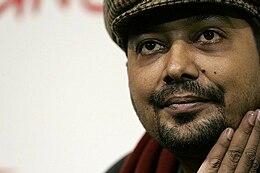
Kashyap attending the Rome Film Festival in 2007.
Anurag Kashyap is an Indian filmmaker and actor, known for his work in Hindi cinema. After writing a television series Kabhie Kabhie (1997), Kashyap co-wrote Ram Gopal Varma's crime drama Satya (1998). He later wrote and directed a short television film, Last Train to Mahakali (1999), and made his feature film debut with the yet-unreleased film Paanch. He next directed Black Friday (2007), a film on the 1993 Bombay bombings. Its release was barred by India's Censor Board for two years, but was eventually released in 2007 to positive reviews. The same year, he directed the critical and commercial failure No Smoking. Return of Hanuman (2007), an animated film, was Kashyap's next directorial venture. In 2009, he directed Dev.D, a modern-day take on Sarat Chandra Chattopadhyay's Bengali novel Devdas, along with the political drama Gulaal. Despite positive reviews, the latter was a box-office failure.
Kashyap's production company Anurag Kashyap Films released its first film Udaan (2010)—a critical success that earned him the Filmfare Award for Best Story and Best Screenplay. He then directed one of the short films in the anthology film Mumbai Cutting. After directing the thriller That Girl in Yellow Boots (2011), the two-part crime film Gangs of Wasseypur (2012) was his next release, which garnered him the Filmfare Award for Best Dialogue. In 2013, he directed a short film on eve teasing titled That Day After Everyday, and directed one segment of the anthology film Bombay Talkies (2013). In 2013, he co-produced The Lunchbox, a film that was nominated for the BAFTA Award for Best Film Not in the English Language, and the biographical drama Shahid. In 2011, Kashyap started another production company Phantom Films, whose first feature was the period drama Lootera (2013). (Full article...) -
Image 16Paradesi (transl. Vagabond) is a 2013 Indian Tamil-language period drama film written, produced and directed by Bala. The film features Atharvaa and Vedhika in the lead roles, with Sai Dhanshika, Uday Karthik, Riythvika and Jerry in supporting roles. The soundtrack and score were composed by G. V. Prakash Kumar. The cinematography was handled by Chezhiyan, while Kishore Te and L. V. K. Das were in charge of the editing. Based on Paul Harris Daniel's 1969 novel Red Tea, the film's story revolves around Raasa (Atharvaa), an unemployed villager who is misled into bonded labour at a tea plantation after being promised generous accommodation and wages by its supervisor (Jerry).
Paradesi was made on a budget of ₹400 million and was released on 15 March 2013 to critical acclaim, but failed at the box office. The film won 37 awards from 59 nominations; its direction, performances of the cast members, music, cinematography, and costumes have received the most attention from award groups. (Full article...) -
Image 17Mani Ratnam is an Indian filmmaker who works predominantly in Tamil cinema. Regarded as one of the greatest Indian filmmakers, he is credited with redefining the "range and depth of Tamil cinema". As of 2019, he has directed 28 films, and produced over 15 under his production company Madras Talkies.
Mani Ratnam made his directorial debut, without formal training or education in filmmaking, with the Kannada film Pallavi Anu Pallavi (1983). The critically acclaimed film, which he also wrote, won him the Karnataka State Film Award for Best Screenplay. Then he entered Malayalam film industry with Unaroo, which was based on then prevailing trade union politics. His first Tamil film Pagal Nilavu (1985) was a commercial failure, but immediately followed Idaya Kovil (1985) found theatrical success. The following year, he made the romantic drama Mouna Ragam, which narrated the story of a young woman who is forced into an arranged marriage by her family. The critical and commercial success of the film established him as a leading filmmaker in Tamil cinema. His next release Nayakan, starring Kamal Haasan, was inspired by the life of the Bombay-based gangster Varadarajan Mudaliar. The film was submitted by India as its official entry for the 60th Academy Awards. Later in 2005, Nayakan was included in Time's "All-Time 100 Movies" list. Mani Ratnam followed this with the tragic romance Geethanjali (1989), which marked his Telugu cinema debut; the tragedy Anjali (1990), which narrated the story of an autistic child; and the crime drama Thalapathi (1991), loosely adapted from the Indian epic Mahabharata. In 1992, he made the romantic thriller Roja for Kavithalayaa Productions. The film was dubbed into many Indian languages, including Hindi, and its widespread success brought national recognition to Mani Ratnam. Three years later, he made Bombay (1995), which was based on the 1992–93 Bombay riots. Although controversial for its depiction of religious riots, the film met with wide critical acclaim and became commercially successful in India. (Full article...) -
Image 18
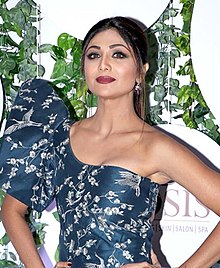
Shetty in 2018
Shilpa Shetty is an Indian actress who is primarily known for her work in Hindi films, in addition to a few Telugu, Kannada and Tamil films. Shetty made her acting debut opposite Shah Rukh Khan in the 1993 thriller Baazigar. Shetty's performance earned her two Filmfare Awards nominations for Lux New Face of the Year and Best Supporting Actress. She subsequently earned recognition with dual roles in the 1994 action-comedy Main Khiladi Tu Anari. After initial success, Shetty's films fared poorly at the box office for the next five years. Films Shetty starred in including action drama Aag, romantic drama Aao Pyaar Karen, comedy Haathkadi and Chhote Sarkar proved to be financially unsuccessful.
The 2000 romantic drama Dhadkan marked a turning point in her career, earning her several nominations in the Best Actress category at various award ceremonies. Shetty played the lead female in films such as family drama Apne, police drama Garv: Pride and Honour and musical drama Life in a... Metro. Her comic performance as an eccentric fisherwoman in 2002 action-drama release Rishtey earned her a nomination for the Filmfare Best Supporting Actress Award. Shetty became a global figure after winning the 2007 British reality television series Celebrity Big Brother, after comments made by other contestants about Shetty fell afoul of Ofcom rules and caused an international controversy over racism. (Full article...) -
Image 19

Mukerji in 2021
Hindi film actress Rani Mukerji made her screen debut in Biyer Phool (1996), a Bengali film directed by her father Ram Mukherjee. Her first leading role was that of a rape victim in the 1996 social drama Raja Ki Aayegi Baaraat. In 1998 she received wider recognition for her role alongside Aamir Khan in the action film Ghulam, and had her breakthrough as the romantic interest of Shah Rukh Khan's character in the romantic drama Kuch Kuch Hota Hai. The latter earned Mukerji her first Filmfare Award in the Best Supporting Actress category. She followed this by playing the leading lady in several films, including Hello Brother (1999) and Nayak: The Real Hero (2001), none of which helped propel her career forward.
Mukerji's career prospects improved in 2002 when she starred in Yash Raj Films' Saathiya, a romantic drama that gained her a Filmfare Critics Award for Best Actress. For her roles in the 2004 romantic comedy Hum Tum and the composite drama Yuva, Mukerji became the only actress to win both the Filmfare Award for Best Actress and Best Supporting Actress, respectively, in the same year. Also that year, she starred in Veer-Zaara—the highest-grossing Bollywood film of the year. In 2005, she received praise for portraying a blind, deaf and mute woman in the drama Black, and played a con woman in the crime comedy film Bunty Aur Babli. For her performance in Black, she was awarded the Best Actress and Best Actress (Critics) trophies at Filmfare. The following year, she played an unhappily married woman in the drama Kabhi Alvida Naa Kehna — the top-grossing Bollywood film in overseas at that point. (Full article...) -
Image 20

Rahul Dravid during the Australian tour of India in 2004
Rahul Dravid is a retired Indian international cricketer. in both Test and One Day International (ODI) cricket in matches organised by the International Cricket Council (ICC). Nicknamed "The Wall" for his ability of "... fending off the fiercest, the fastest and the wiliest of bowlers around the world", he scored 36 centuries (scores of 100 runs or more) in Test cricket and 12 in One Day Internationals (ODI) between his debut in 1996 and retirement in 2011. He was named as one of the five Wisden Cricketers of the Year in 2000, as well as the ICC Test Player of the Year and ICC Player of the Year in 2004.
Dravid scored his first Test century in January 1997 against South Africa. In a man-of-the-match performance, he made 148 runs spanning nine hours and took India to their only draw of the series. He made centuries in both innings of a match when he scored 190 and 103 not out in the final Test of the 1998–99 series against New Zealand. He repeated the feat in March 2005 when he scored 110 and 135 against Pakistan in another man-of-the-match performance, leading India to victory in the second of the three-match series. Scoring 180 in a fifth-wicket partnership of 376 with VVS Laxman, in the Second Test of the Border-Gavaskar Trophy in 2001, Dravid helped lead India to victory by 171 runs despite being asked to follow-on by the Australians. His partnership with Laxman was the third-highest for the fifth wicket in Test cricket history. Dravid's highest Test score of 270, achieved in April 2004 in Rawalpindi, helped India to an innings victory against Pakistan. The performance was the fourth-highest score by an Indian batsman in Test cricket. He scored centuries against all Test playing nations and was the first cricketer to score centuries in all 10 Test playing nations. (Full article...) -
Image 21The J. C. Daniel Award is the highest award in Malayalam cinema, established by the Government of Kerala, India. It is presented annually by the Kerala State Chalachitra Academy, a non-profit institution operating under the Department of Cultural Affairs, Kerala. Instituted in 1992, the award recognizes individuals for their "outstanding contributions to Malayalam cinema". Recipients are selected by a jury appointed by the Kerala State Chalachitra Academy and the Department of Cultural Affairs. As of 2021, the honourees receive a statuette, a citation, and a cash prize of ₹500,000 (US$5,800). They are honoured at the Kerala State Film Awards ceremony.
The Government of Kerala created the award to commemorate the contribution of Indian filmmaker J. C. Daniel, who is often regarded as the "father of Malayalam cinema". The J. C. Daniel Award was managed by the Department of Cultural Affairs until 1997. In 1998, the Government of Kerala constituted the Kerala State Chalachitra Academy, and since that year, the Academy has hosted the award. A cash prize of ₹50,000 (US$580) was granted with the award until 2002. In 2003, the prize money was doubled and, as part of a technical correction to update it, no award was presented that year. Actor Madhu was the first recipient of the award with the increased monetary prize of ₹100,000 (US$1,200) in 2004. Since 2016, the cash prize is ₹500,000 (US$5,800). (Full article...) -
Image 22

Kangana Ranaut's performance in Queen garnered her several awards and nominations including the National Film Award for Best Actress at the 62nd National Film Awards.
Queen is a 2013 Indian comedy-drama film directed by Vikas Bahl and produced by Anurag Kashyap and Vikramaditya Motwane. The film stars Kangana Ranaut in the lead role, and features Rajkummar Rao and Lisa Haydon in supporting roles. The film was edited by Abhijit Kokate and Kashyap, and the cinematography was provided by Bobby Singh. Amit Trivedi composed the musical score for the film. Queen tells the story of Rani, an under-confident woman, who embarks on her honeymoon alone after her fiancé calls off their wedding.
Made on a budget of ₹125 million (US$1.4 million), Queen was released on 7 March 2014, and grossed ₹970 million (US$11 million) worldwide. The film garnered awards and nominations in several categories, with particular praise for its direction, performance of Ranaut, cinematography, and editing. As of June 2015, the film has won 32 awards. (Full article...) -
Image 23
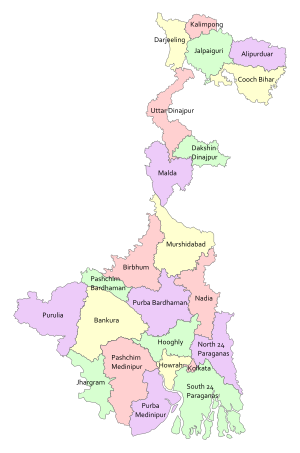
Districts of West Bengal
The Himalayas lies in the north of West Bengal and the Bay of Bengal is at the south. Between them, the river Ganga flows eastwards and its main distributary, the Hooghly River, flows south to reach the Bay of Bengal. The Siliguri Corridor, which connects North-East India with rest of the India, lies in the North Bengal region of the state. Geographically, West Bengal is divided into a variety of regions—Darjeeling Himalayan hill region, Terai and Dooars region, North Bengal plains, Rarh region, Western plateau and high lands, coastal plains, Sundarbans and the Ganga Delta.
In 1947, when India gained independence, the state of West Bengal was formed, with 14 districts, as per partition plan of the then Bengal province of British India. The former princely state Koch Bihar joined as a district on 26 January 1950, and the former French enclave Chandannagore joined as part of the Hooghly district in 1954. The States Reorganisation Act of 1956 led to addition of Purulia district to the state and to enlargement of West Dinajpur district. Later, larger districts such as West Dinajpur, 24 Parganas and Midnapore were bifurcated. (Full article...) -
Image 24

The Mizoram Legislative Assembly is the unicameral legislature of Mizoram state in Northeast India. The seat of the legislative assembly is at Aizawl, the capital of the state. The assembly comprises 40 members directly elected from single-seat constituencies. It sits for a term of five years, unless it is dissolved earlier. Early dissolution of state assemblies happens when the governing party (or alliance) loses confidence of the assembly. This leads to either the President's Rule being imposed on the state, or early elections being called. Mizoram is the fourth-smallest state in India, covering 21,081 km2 (8,139 sq mi); and the second-least populous state with a population of 1.10 million. The Mizoram Legislative Assembly has existed since 1972, when it had 30 constituencies.
Since the independence of India, the Scheduled Castes (SC) and Scheduled Tribes (ST) have been given Reservation status, guaranteeing political representation, and the Constitution lays down the general principles of positive discrimination for STs and SCs. The 2011 census of India stated that the indigenous population constitutes 95% of the state's total population. The Scheduled Tribes have been granted a reservation of 39 seats in the Mizoram assembly, leaving only one (Aizawl East-I) unreserved. (Full article...) -
Image 25
Suriya is an Indian actor and film producer who works primarily in Tamil cinema. He made a commercially successful cinematic debut in Vasanth's Nerrukku Ner (1997). After few critical and commercial failures, Suriya collaborated with Vasanth again in Poovellam Kettuppar (1999), his first film with his future wife Jyothika.
In 2001, Suriya starred in Bala's Nandha as an ex-convict trying to find his place in society. The film was critically acclaimed and became a turning point in his career. His roles as a police officer in Gautham Vasudev Menon's Kaakha Kaakha (which became his first blockbuster) and a con artist in Bala's Pithamagan, established him as one of Tamil cinema's leading actors. Suriya's performances in both films were praised, winning him a Best Actor nomination for the former and the Best Supporting Actor for Pithamagan at the 51st Filmfare Awards South. The following year, he played dual roles—a hunchback and a college student—in Perazhagan. Suriya's performance was again praised, and he received his first Filmfare Best Actor award. He was also acclaimed for his performance as a student leader in Mani Ratnam's Aayutha Ezhuthu (2004). (Full article...)
 Good article – show another
Good article – show another
-
Image 1
Sri Aurobindo (born Aurobindo Ghose; 15 August 1872 – 5 December 1950) was an Indian philosopher, yogi, maharishi, poet, Educationalist
and Indian nationalist. He was also a journalist, editing newspapers such as Bande Mataram. He joined the Indian movement for independence from British colonial rule, until 1910 was one of its influential leaders, and then became a spiritual reformer, introducing his visions on human progress and spiritual evolution.
Aurobindo studied for the Indian Civil Service at King's College, in Cambridge, England. After returning to India he took up various civil service works under the Maharaja of the princely state of Baroda and became increasingly involved in nationalist politics in the Indian National Congress and the nascent revolutionary movement in Bengal with the Anushilan Samiti. He was arrested in the aftermath of a number of bombings linked to his organization in a public trial where he faced charges of treason for Alipore Conspiracy. However, Sri Aurobindo could only be convicted and imprisoned for writing articles against British colonial rule in India. He was released when no evidence could be provided, following the murder of a prosecution witness, Narendranath Goswami, during the trial. During his stay in the jail, he had mystical and spiritual experiences, after which he moved to Pondicherry, leaving politics for spiritual work. (Full article...) -
Image 2Uyarndha Manithan (transl. The Noble Man) is a 1968 Indian Tamil-language drama film written by Javar Seetharaman and directed by Krishnan–Panju. The film was produced by A. V. Meiyappan, M. Saravanan, M. Kumaran and M. Murugan under AVM Productions. It stars Sivaji Ganesan and Sowcar Janaki, while S. A. Ashokan, Major Sundarrajan, Vanisri and Sivakumar play pivotal roles. The film's soundtrack and background score were composed by M. S. Viswanathan, while the lyrics for the songs were written by Vaali.
The film was Sivaji Ganesan's 125th as an actor. It was a remake of the 1966 Bengali film Uttar Purush. The plot revolves around a wealthy industrialist's son who secretly marries the daughter of his family estate's accountant, only for his father to discover it and burn down the estate along with his son's pregnant wife, who is inside. The remainder of the film reveals the truth behind how she and her progeny survive. (Full article...) -
Image 3Sukumar promoting 1: Nenokkadine in 2014
Bandreddi Sukumar (born 11 January 1970) is an Indian film director, screenwriter, and producer who works in Telugu cinema. He is known for his complex, multi-layered screenplays and for infusing grey shades into the characterisation of his protagonists. Sukumar is also one of the highest-paid directors in Indian cinema.
Before entering the film industry, Sukumar worked as a mathematics and physics lecturer at a junior college in Kakinada for nearly seven years. He began his film career as a writer, collaborating with Editor Mohan, before assisting V. V. Vinayak on Dil (2003). Sukumar made his directorial debut with Arya (2004), which was a major success. His work on Arya earned him the Filmfare Award for Best Director – Telugu and Nandi Award for Best Screenplay Writer. (Full article...) -
Image 4
Kajol Devgan (née Mukherjee) (Bengali pronunciation: [kad͡ʒol]; born 5 August 1974), known mononymously as Kajol, is an Indian actress. Described in the media as one of the most successful actresses of Hindi cinema, she is the recipient of numerous accolades, such as six Filmfare Awards, which include a record-tying five Best Actress wins. In 2011, she was honoured with the Padma Shri by the Government of India.
The daughter of Tanuja and Shomu Mukherjee, Kajol made her acting debut with Bekhudi (1992) while still in school. She subsequently quit her studies, and had commercial successes in Baazigar (1993), and Yeh Dillagi (1994). Starring roles in the top-grossing romances Dilwale Dulhania Le Jayenge (1995) and Kuch Kuch Hota Hai (1998) established her as a leading star in the 1990s and earned her two Filmfare Awards for Best Actress. She also gained critical appreciation for playing a psychopathic killer in Gupt: The Hidden Truth (1997) and an avenger in Dushman (1998). (Full article...) -
Image 5
The Shivalik class or Project 17 class is a class of multi-role frigates in service with the Indian Navy. They are the first warships designed with low observability features built in India. They were designed to have better stealth features and land-attack capabilities than the preceding Talwar-class frigates. A total of three ships were built between 2000 and 2010, and all three were in commission by 2012.
The Shivalik class, along with the seven Project 17A frigates currently being developed from them, are projected be the principal frigates of the Indian Navy in the first half of the 21st century. The class and the lead vessel have been named for the Shivalik hills. Subsequent vessels in the class are also named for hill ranges in India. (Full article...) -
Image 6Jain temples on Shatrunjaya hill near Palitana, Gujarat
Jainism (/ˈdʒeɪnɪzəm/ JAY-niz-əm), also known as Jain Dharma, is an Indian religion. Jainism traces its spiritual ideas and history through the succession of twenty-four tirthankaras (supreme preachers of dharma), with the first in the current time cycle being Rishabhadeva, whom the tradition holds to have lived millions of years ago, the twenty-third tirthankara Parshvanatha, traditionally dated to the 9th century BCE, and the twenty-fourth tirthankara Mahavira, historically around the 6th or 5th BCE. Jainism is considered an eternal dharma with the tirthankaras guiding every time cycle of the cosmology. Central to understanding Jain philosophy is the concept of bhedavijñāna, or the clear distinction in the nature of the soul and non-soul entities. This principle underscores the innate purity and potential for liberation within every soul, distinct from the physical and mental elements that bind it to the cycle of birth and rebirth. Recognizing and internalizing this separation is essential for spiritual progress and the attainment of samyaka darśana or self realization, which marks the beginning of the aspirant's journey towards liberation. The three main pillars of Jainism are ahiṃsā (non-violence), anekāntavāda (non-absolutism), and aparigraha (asceticism).
Jain monks take five main vows: ahiṃsā (non-violence), satya (truth), asteya (not stealing), brahmacharya (chastity), and aparigraha (non-possessiveness). These principles have affected Jain culture in many ways, such as leading to a predominantly lacto-vegetarian lifestyle. Parasparopagraho jīvānām (the function of souls is to help one another) is the faith's motto, and the Namokar Mantra is its most common and strongest prayer. (Full article...) -
Image 7
The 1990 Andhra Pradesh cyclone was the worst disaster to affect Southern India since the 1977 Andhra Pradesh cyclone. The system was first noted as a depression on 4 May 1990, while it was located over the Bay of Bengal about 600 km (375 mi) to the southeast of Chennai, India. During the next day the depression intensified into a cyclonic storm and started to intensify rapidly, becoming a super cyclonic storm early on 8 May. The cyclone weakened slightly before it made landfall on India about 300 km (190 mi) to the north of Madras in the Tamil Nadu state as a very severe cyclonic storm with winds of 165 km/h (105 mph). While over land the cyclone gradually dissipated. The cyclone had a severe impact on India, with over 967 people reported to have been killed. Over 100,000 animals also died in the cyclone with the total cost of damages to crops estimated at over $600 million (1990 USD). (Full article...) -
Image 8Chauhan performing at Jawaharlal Nehru Stadium for her I AM HOME Tour c. 2024
Sunidhi Chauhan (pronounced [sʊnɪd̪ʱiː ʧɔːɦäːn]; born Nidhi Chauhan, 14 August 1983) is an Indian playback singer. Known for her vocal range and versatility, she has recorded songs for films in several Indian languages and received accolades including three Filmfare Awards and a Filmfare Award South .She is often praised for her charismatic stage presence and Vocal belting ability.
Born in Delhi, she began performing at local gatherings at the age of 5 and made her career debut at the age of 13, with the film Shastra (1996). During the year, she won the first singing reality show titled Meri Awaz Suno and rose to prominence after recording "Ruki Ruki Si Zindagi" from Mast (1999). It won her Filmfare RD Burman Award for New Music Talent and was nominated for the Best Female Playback Singer. She is known for her versatility as a vocalist. (Full article...) -
Image 9Seethamma Vakitlo Sirimalle Chettu (transl. The jasmine vine in Seethamma's courtyard), also known by the initialism SVSC, is a 2013 Indian Telugu-language family drama film co-written and directed by Srikanth Addala. It was produced by Dil Raju's Sri Venkateswara Creations, and stars Venkatesh, Mahesh Babu, Anjali and Samantha, while Prakash Raj, Jayasudha, Rao Ramesh, Kota Srinivasa Rao, Abhinaya and Rohini Hattangadi play supporting roles.
In addition to directing the film, Addala worked on the script for three years after the release of his directorial debut, Kotha Bangaru Lokam (2008). He wrote the screenplay, and Ganesh Patro wrote the film's dialogue. Mickey J. Meyer and Mani Sharma composed the soundtrack and score, respectively. Marthand K. Venkatesh edited the film and K. V. Guhan was its cinematographer. Production began on 6 October 2011 in Hyderabad; principal photography began on 18 January 2012 in Visakhapatnam, and finished on 24 December. In addition to Hyderabad, scenes were filmed in coastal Andhra Pradesh, Tamil Nadu and Kerala. (Full article...) -
Image 10Mary Kom is a 2014 Indian Hindi-language biographical sports film based on the life of the eponymous boxer Mary Kom, directed by Omung Kumar and produced by Viacom18 Motion Pictures and Sanjay Leela Bhansali. The film stars Priyanka Chopra in the lead role, with newcomer Darshan Kumar and Sunil Thapa in the supporting roles of her husband and mentor, respectively, and depicts Kom's journey from becoming a boxer to her victory at the 2008 World Boxing Championships in Ningbo. The film marks the Hindi playback singing debut of Chopra, who provided her vocals for a song named "Chaoro" (a Meiteilon lullaby).
Mary Kom was developed by the writer Saiwyn Quadras, who suggested the storyline to Kumar when Kom was not a familiar name in India despite her numerous achievements. Kumar met Kom to ask her permission for the film, before her bronze medal victory at the 2012 Summer Olympics, which brought her recognition. Chopra underwent extensive physical training for four months to attain a muscular physique and learned the sport and Kom's distinct boxing style. Principal photography started in June 2013 at Filmistan, where the boxing sequences were filmed. After plans to shoot in Kom's hometown, Manipur, were dropped due to safety concerns, Mary Kom was shot in Dharamshala and Manali, where a major portion of Manipur was recreated. (Full article...) -
Image 11Brindavana (tomb) of Satyanatha Tirtha at Veeracholapuram
Satyanatha Tirtha (also known as Satyanatha Yati) (Sanskrit:सत्यनाथा तीर्थ); IAST:Śrī Satyanātha Tīrtha) (c.1648 – c.1674), also called Abhinava Vyasaraja, was a Hindu philosopher, scholar, theologian, logician and dialectician belonging to the Dvaita order of Vedanta. He served as the twentieth pontiff of Uttaradi Math from 1660 to 1673. He was a fiery and prolific writer and very ambitious of the glory of Dvaita Vedanta. He is considered to be one of the stalwarts in the history of the Dvaita school of thought, on account of his sound elucidations of the works of Madhvacharya, Jayatirtha and Vyasatirtha. Three of his polemically themed doxographical works (Abhinavamruta, Abhinava Chandrika and Abhinava Tarkatandava) are reminiscent of "Vyasatraya" (the three eyes of the man-lion of Madhva Siddhāntha). His refutation work Abhinava Gada is a devastating criticism of Appayya's Madhvamathamukhamardhana. His independent treatise Abhinava Chandrika is considered a brilliant work relating to the Brahma Sūtras, being a commentary on Jayatirtha's Tattvaprakashika. His work Abhinava Tarka Tandava refuted the works of rival systems, especially those of Prabhākara of Mimamsa, Ramanuja's Visistadvaita, and Gangesha Upadhyaya, Raghunatha Siromani of the Nyaya school, on the same lines as Vyasatirtha's Tarka Tandava. Indologist B.N.K.Sharma wrote, "His energy and determination to crush out the rivalry of Monism is reflected even in the choice of the titles of some of his works, four of which go by the name "Paraśus" (the Axe)".
Born into a family of scholars, Satyanatha Tirtha studied the six orthodox schools of Hinduism and subsequently, the philosophy of Dvaita under Satyanidhi Tirtha of Uttaradi Math, eventually succeeding him as the pontiff. B.N.K.Sharma wrote, "Satyanatha Tirtha made a bold pronouncement that women and Shudras are eligible for Aparokshajnana exclusively through shravana of Tantra". Sharma also wrote, "Satyanatha holds the memory of Vyasatirtha in warm admiration and refers him reverentially as Vyāsatīrthasrimaccaranah". He composed 12 works, consisting of commentaries on the works of Madhva, Jayatirtha and Vyasatirtha, and several independent treatises criticizing the tenets of contemporary schools, especially Advaita, while simultaneously elaborating upon the Dvaita thought. His dialectical skill and logical acumen is often compared with that of Vyasatirtha. (Full article...) -
Image 12
Company Quartermaster Havildar Abdul Hamid Idrishi PVC (1 July 1933 – 10 September 1965), was an Indian soldier. He was posthumously given India's highest military decoration, the Param Vir Chakra, for his actions during the Indo-Pakistani War of 1965.
Hamid joined the army in December 1954, and was posted to the 4th Battalion of the Grenadiers regiment. During the Sino-Indian War, his battalion participated in the battle of Namka Chu against the Chinese People's Liberation Army. During the Indo-Pakistani War of 1965, the 4 Grenadiers battalion was entrusted with a vital position before the village of Chima on the Khem Karan–Bhikhiwind line. At the Battle of Asal Uttar on 9–10 September 1965, Hamid destroyed eight Pakistani tanks and was killed in action destroying the ninth tank. (Full article...) -
Image 13Black is a 2005 Indian drama film co-written, directed, and co-produced by Sanjay Leela Bhansali. It stars Amitabh Bachchan and Rani Mukerji in lead roles, with Ayesha Kapur, Shernaz Patel and Dhritiman Chatterjee in supporting roles. The film narrates the story of Michelle (Mukerji), a deafblind woman, and her relationship with her teacher Debraj (Bachchan), an elderly alcoholic teacher who himself later develops Alzheimer's disease.
In 2003, Bhansali announced the production of his new project, Black. Its idea first came up when he met several physically disabled children while shooting Khamoshi: The Musical in the 1990s. The story was inspired by the activist Helen Keller's life and her 1903 autobiography, The Story of My Life. Principal photography was done by Ravi K. Chandran in 100 days from mid-January to April 2004, taking place in Shimla and Film City. Omung Kumar was the production designer, while Sham Kaushal was the action director. After filming, it was edited by Bela Sehgal. The soundtrack and score were composed by Monty Sharma. (Full article...) -
Image 14
The Indian Antiquary: A journal of oriental research in archaeology, history, literature, language, philosophy, religion, folklore, &c, &c (subtitle varies) was a journal of original research relating to India, published between 1872 and 1933. It was founded by the archaeologist James Burgess to enable the sharing of knowledge between scholars based in Europe and in India and was notable for the high quality of its epigraphic illustrations which enabled scholars to make accurate translations of texts that in many cases remain the definitive versions to this day. It was also pioneering in its recording of Indian folklore. It was succeeded by The New Indian Antiquary (1938–47) and the Indian Antiquary (1964–71). (Full article...) -
Image 15

A 17th-century wooden sculpture of Putana with Krishna from Kerala
In Hinduism, Pūtanā (lit. 'putrefaction') is a rakshasi (demoness), who was killed by the infant-god Krishna. Putana disguises as a young, beautiful woman and tries to kill the god by breast-feeding poisoned milk; however Krishna sucks her milk as well as her life via her breasts. Putana is also considered as a foster-mother of Krishna as she breast-fed him. By offering her milk, Putana had performed "the supreme act of maternal devotion", in the shadow of her evil motives. The legend is told and retold in Hindu scriptures and some Indian books, which portray her variously as an evil hag or a demoness who surrendered herself to Krishna, though she initially came with evil motives.
Putana is interpreted as an infantile disease or bird, symbolizing danger to an infant or desire respectively, and even as a symbolic bad mother. She is included in a group of malevolent Hindu mother goddesses called the Matrikas and also in the group of Yoginis and Grahinis (Seizers). Ancient Indian medical texts prescribe her worship to protect children from diseases. A group of multiple Putanas is mentioned in ancient Indian texts. (Full article...) -
Image 161: Nenokkadine (transl. 1: I am alone) is a 2014 Indian Telugu-language psychological action thriller film directed by Sukumar. Produced by 14 Reels Entertainment and distributed by Eros International, the film stars Mahesh Babu and Kriti Sanon (in her film debut) in lead roles. Nassar, Pradeep Rawat, and Kelly Dorji appear in supporting roles. The story follows Gautham, a rock musician suffering from schizophrenia and missing 25 percent of his brain's grey matter, as he embarks on a quest to find his parents with the help of his girlfriend, Sameera, a journalist.
Sukumar began working on the film's script after completing 100% Love (2011), using a bus driver's tale about a boy claiming his parents were murdered on his bus as the foundation. 1: Nenokkadine features cinematography by R. Rathnavelu and editing by Karthika Srinivas. The music was composed by Devi Sri Prasad. Principal photography commenced in April 2012 and concluded in October 2013. Filming took place in various locations including London, Belfast, Bangkok, and Indian cities such as Hyderabad, Mumbai, Goa, Chennai, and Bangalore. Produced on a budget of ₹60–70 crore, it was the most expensive Telugu film at the time of its release. (Full article...) -
Image 17

Kodandera Madappa Cariappa (28 January 1899 – 15 May 1993) was an Indian military officer and diplomat who was the Indian Commander-in-Chief (C-in-C) of the Indian Army. He led Indian forces on the Western Front during the Indo-Pakistani War of 1947. He was appointed Commander-in-Chief of the Indian Army in 1949. He is one of only two Indian Army officers to hold the five-star rank of Field Marshal; the other being Field Marshal Sam Manekshaw.
His distinguished military career spanned almost three decades. Born in Madikeri, Kodagu, Cariappa joined the British Indian Army shortly after the end of World War I, and was commissioned as a temporary first lieutenant into the 2/88 Carnatic Infantry. He was transferred between multiple regiments early in his career before settling on 1/7 Rajputs, which became his permanent regiment. (Full article...) -
Image 18
Fasana-e-Azad (Urdu: فسانۂ آزاد; transl. The Adventures of Azad, also romanized as Fasana-i-Azad) is an Urdu novel by Ratan Nath Dhar Sarshar. It was serialized in Avadh Akhbar between 1878 and 1883 before it was published in four large volumes by the Nawal Kishore Press. The story follows a wandering character named Azad and his companion, Khoji, from the streets of late-nineteenth-century Lucknow to the battlefields of the Russo-Turkish War (1877–1878) in Constantinople and Russia. The work's status as a novel has been debated, but it is thought by most scholars to be one of the first novels (or a proto-novel) in Urdu.
Sarshar conceived of writing Fasana-e-Azad after the success of the articles he contributed to Avadh Akhbar under the title "Zarafat" ("Wit and Humour"). Perennially popular, Fasana-e-Azad has been a subject of study by literary critics as the first Urdu novel and for its influence on the literary form's later development. It is noted for its colourful descriptions of Lucknow, its people, and its culture. (Full article...) -
Image 19
The State Council of Sikkim was the unicameral legislature of the former Kingdom of Sikkim, which was located in the Himalayas, between India and China.
There were six elections held for the council between 1953 and 1974. In 1975, after a referendum to abolish the monarchy, and the passing of the 36th amendment to the Indian constitution, the monarchy was abolished, along with the State Council. The territory of the kingdom was merged with India, becoming its 22nd state. The members of the State Council at the time, were deemed to be the Legislative Assembly of the newly formed state. (Full article...) -
Image 20
Devasena (Sanskrit: देवसेना, lit. 'Army of the devas', IAST: Devasenā, Tamil: தேவசேனா, romanized: Tēvacēṉā) is the Hindu goddess of aspirations, and the consort of the war god Kartikeya (Murugan). She is also known as Devayanai, Deivanai, and Deivayanai in Tamil texts. Her name is also spelled as Teyvanai or Tevayanai (Teyvāṉai).
Devasena is described as the daughter of the Prajapati Daksha in the Mahabharata, while some Sanskrit scriptures consider her as the daughter of Indra, the king of the devas (gods), and his wife Shachi. In the Tamil iteration of the Skanda Purana, she is portrayed as the daughter of the god Vishnu, who is later adopted by Indra. She is betrothed to Kartikeya by Indra, when he becomes the commander-in-chief of the devas. In Tamil accounts, Devasena is generally depicted as an antithesis of Valli, her sister-wife; together they complete the deity. Devasena is generally depicted with Murugan, and is often also accompanied by Valli. (Full article...) -
Image 21
The Mountain railways of India are the railway lines that were built in the mountainous regions of India. The term mainly includes the narrow-gauge railways in these regions but may also include some broad-gauge railways.
Three of the lines, the Darjeeling Himalayan Railway, the Nilgiri Mountain Railway, and the Kalka–Shimla Railway, are collectively designated as a UNESCO World Heritage Site under the name "Mountain Railways of India". Two more, the Matheran Hill Railway and the Kangra Valley Railway, are on the tentative list of UNESCO World Heritage Sites. The Nilgiri Mountain Railway is also the only rack and pinion railway in India. (Full article...) -
Image 22Eurekha! is a biography of the actress Rekha by the columnist and author Mohan Deep. The book details her Bollywood acting career and her short-term marriage with the industrialist Mukesh Aggarwal. It was published on 17 December 1999 by Shivani Publications and later reprinted in a number of Indian languages, including a serialisation in the magazine Anandalok. It received negative reviews from critics, who panned Deep's writing and the book's contents. Rekha herself was critical of the book due to its misinformation. (Full article...)
-
Image 23

Rajiv Gandhi International Airport (IATA: HYD, ICAO: VOHS) is an international airport that serves Hyderabad, the capital of the Indian state of Telangana. It is located in Shamshabad, about 24 kilometres (15 mi) south of Hyderabad and it was opened on 23 March 2008 to replace Begumpet Airport, which was till then the sole civilian airport serving Hyderabad. It is named after Rajiv Gandhi, former Prime Minister of India. Built over an area of 5,500 acres (2,200 ha), it is the largest airport of India by area. It is owned and operated by GMR Hyderabad International Airport Limited (GHIAL), a public–private consortium. It was the first airport in India to launch domestic e-boarding facility in December 2015 and international e-boarding facility in October 2020. It has ranked in AirHelp's list of top 10 airports in the world. The fourth busiest airport in India by passengers traffic, it handled over 25 million passengers and around 150,000 tonnes (170,000 short tons) of cargo between April 2023 and March 2024.
The airport is India's first greenfield airport built under a public-private partnership model. The airport has an integrated passenger terminal, a cargo terminal and two runways. There are also aviation training facilities, a fuel farm, a solar power plant and two maintenance, repair, and operations (MRO) facilities. (Full article...) -
Image 24Devdas is a 2002 Indian Hindi-language period romantic drama film directed by Sanjay Leela Bhansali and produced by Bharat Shah under his banner, Mega Bollywood. It stars Shah Rukh Khan, Aishwarya Rai and Madhuri Dixit in lead roles, with Jackie Shroff, Kirron Kher, Smita Jaykar, and Vijayendra Ghatge in supporting roles. Based on the 1917 novel of the same name by Sarat Chandra Chattopadhyay, the film narrates the story of Devdas Mukherjee (Khan), a wealthy law graduate who returns from London to marry his childhood friend, Parvati "Paro" (Rai). However, the rejection of their marriage by his own family sparks his descent into alcoholism, ultimately leading to his emotional deterioration and him seeking refuge with the golden-hearted courtesan Chandramukhi (Dixit).
Bhansali was inspired to remake the novel into a film after reading it for a second time, and announced the project in November 1999. The screenplay was written by him and Prakash Ranjit Kapadia, who also wrote the dialogue. Nitin Chandrakant Desai built the sets between August 2000 and May 2001, spending ₹200 million (US$4.12 million). Along with Bhansali and other crews, he did extensive research on Calcuttan building design from the period of the British Raj. Principal photography was handled by Binod Pradhan from November 2000 to April 2002, taking place in Bikaner, Film City, and Filmistan. While Ismail Darbar and Birju Maharaj composed the soundtrack, Monty Sharma composed the background score. (Full article...) -
Image 25
Ranveer Singh Bhavnani (pronounced [rəɳˈʋiːr sɪŋ]; born 6 July 1985) is an Indian actor who works in Hindi films. He is the recipient of several awards, including five Filmfare Awards. He is among the highest-paid Indian actors and has been featured in Forbes India's Celebrity 100 list since 2012.
After graduating from Indiana University Bloomington, Singh worked in advertising for a few years. He made his acting debut with a leading role in Yash Raj Films' romantic comedy Band Baaja Baaraat (2010), winning the Filmfare Award for Best Male Debut. He gained praise for playing a melancholic thief in the drama Lootera (2013) and established himself as a star through his collaborations with Sanjay Leela Bhansali, beginning with Goliyon Ki Raasleela Ram-Leela (2013). He portrayed Bajirao I and Alauddin Khilji in Bhansali's period dramas Bajirao Mastani (2015) and Padmaavat (2018), respectively. He won the Filmfare Award for Best Actor for the former and the Filmfare Critics Award for Best Actor for the latter. (Full article...)
News
- 23 February 2025 –
- American Airlines Flight 292, flying from New York, United States, to New Delhi, India, is forced to divert to Rome Fiumicino Airport in Rome, Italy, due to an unspecified security concern later deemed to be non-credible. The flight was over the Caspian Sea near Turkmenistan when it diverted back towards Europe. (AP)
- In cricket under the ODI format, Indian cricketer Virat Kohli becomes the first player to reach the 51 centuries and the fastest player to reach 14,000 runs. (Times of India) (AP)
- 22 February 2025 –
- A bus carrying passengers to a wedding ceremony overturns in Ranhghati, Rajasthan, India, killing two people and injuring 30 others. (The Times of India)
- 15 February 2025 – 2025 New Delhi railway station stampede
- A crowd crush kills at least 18 people, including three children, and injures ten others at New Delhi railway station in New Delhi, India. (BBC News) (CNN) (Al Jazeera)
- 14 February 2025 –
- Ten people are killed and 19 others are injured in a collision between a car and a bus carrying Hindu pilgrims heading to Kumbh Mela in Prayagraj, Uttar Pradesh, India. (DW)
Did you know...
- ... that Indian historian R. Champakalakshmi was a script consultant for Bharat Ek Khoj, a television series based on Jawaharlal Nehru's The Discovery of India?
- ... that classical dances of Gaddam Padmaja Reddy, recipient of India's highest award for performing arts, explore contemporary social issues such as female foeticide and HIV/AIDS?
- ... that St Mary's Anglican Church, Busselton, Australia, has been a part of six dioceses, namely Canterbury, Calcutta, Sydney, Adelaide, Perth and Bunbury?
- ... that Indian aristocrat and photographer Umrao Singh Sher-Gil left more than 3000 prints and negatives, including many of his daughter Amrita Sher-Gil, documenting life in Europe and India?
- ... that Zakir Husain was the first Muslim and the first governor of a state to be elected President of India?
- ... that Arthur France founded the Leeds West Indian Carnival, the first Caribbean carnival in Europe, in 1967?
Topics related to India
Timeline of Indian history, Indus Valley Civilisation, Dholavira, Science and technology in ancient India, Meluhha, Aryan invasion theory, Out of India theory, Greek conquests in India, Indian maritime history, Maurya Empire, Ashoka, Shunga Empire, Hoysala Empire, Vijayanagara, Satavahana dynasty, Indo-Greek Kingdom, Indo-Scythians, Indo-Parthian Kingdom, Kushan Empire, Western Satraps, Gupta Empire, Chola dynasty, Pala Empire, Islamic incursions in India, Mughal Empire, Maratha Empire, British Raj, East India Company, Governor-General, Viceroy, War of Independence, 1857, Indian independence movement, Indian National Army, Azad Hind, Quit India Movement, Partition of India, History of Republic of India, Non-Aligned Movement, Sino-Indian War, Indo-Pakistani War of 1947–1948, Indo-Pakistani War of 1965, Indo-Pakistani War of 1971, Kargil War, 2001–02 India–Pakistan standoff, Military, Demographic
Law, Hindu law, Constitution, Political parties (Indian National Congress, Bharatiya Janata Party), Foreign relations, Elections, Political divisions, Reservation in India
Government agencies, Legislative branch (Lok Sabha, Rajya Sabha) Executive branch (President & Vice President, Prime Minister & Deputy Prime Minister, Cabinet Ministers, Cabinet Secretary, Election Commission, Foreign Minister; Law enforcement: CBI, CID, Intelligence: IB, RAW), Directorate General of Income Tax Investigation Judicial branch (Supreme Court), Armed Forces (Army, Navy, Air Force, Border Security Force, Coast Guard)
Himalayas, Western Ghats, Eastern Ghats, Indo-Gangetic Plain, Deccan Plateau, Thar Desert, Ganges, Rann of Kutch, Brahmaputra River, Northeast India; Mountains, Valleys, Islands, Rivers; States and union territories, Cities, Districts, Regions, Fauna, Flora
Rupee, Bombay Stock Exchange, National Stock Exchange, Standard of living, Companies, Reserve Bank of India, Energy policy (Solar, Wind, Nuclear), Tourism, Transport (Expressways, Rail transport, Auto rickshaw),
Languages, Standard of living, Religion
Music (Carnatic, Hindustani, Indi-pop), Dance, Languages, Literature, Architecture, Film & TV, Cuisine, Holidays, Folklore, Education, Media, Indian martial arts
Indian Council of Agricultural Research (ICAR), Indian Institute of Astrophysics, National Centre for Software Technology, AIIMS, IISc, IIT, NIT, BITS-Pilani, INRegistry, Indian numbering system, Indian Space Research Organisation, National Internet Exchange of India, ICRISAT, International Institute of Information Technology, Hyderabad
Indian English, Indian nationality law, Numbering system, Indian Space Research Organisation, Telecommunications, National Highways Development Project, Flag, Vehicle registration plates, Indian nationalism, Metrication in India
Categories
Related portals
Religions in India
Indian Subcontinent
Other countries
Wikipedias in Indian languages
- অসমীয়া (Assamese)
- বাংলা (Bengali)
- भोजपुरी (Bhojpuri)
- বিষ্ণুপ্রিয়া মণিপুরী (Bishnupriya Manipuri)
- गोंयची कोंकणी / Gõychi Konknni (Konkani)
- ગુજરાતી (Gujarati)
- हिन्दी (Hindi)
- ಕನ್ನಡ (Kannada)
- कॉशुर/كشميري (Kashmiri)
- मैथिली (Maithili)
- മലയാളം (Malayalam)
- मराठी (Marathi)
- नेपाली (Nepali)
- नेपाल भाषा
- (Newari)
- ଓଡ଼ିଆ (Odiya)
- ਪੰਜਾਬੀ (Punjabi)
- पालि (Pali)
- संस्कृत (Sanskrit)
- ᱥᱟᱱᱛᱟᱲᱤ (Santali)
- سنڌي (Sindhi)
- தமிழ் (Tamil)
- తెలుగు (Telugu)
- ತುಳು (Tulu)
- اردو (Urdu)
Associated Wikimedia
The following Wikimedia Foundation sister projects provide more on this subject:
-
 Commons
Commons
Free media repository -
 Wikibooks
Wikibooks
Free textbooks and manuals -
 Wikidata
Wikidata
Free knowledge base -
 Wikinews
Wikinews
Free-content news -
 Wikiquote
Wikiquote
Collection of quotations -
 Wikisource
Wikisource
Free-content library -
 Wikiversity
Wikiversity
Free learning tools -
 Wikivoyage
Wikivoyage
Free travel guide -
 Wiktionary
Wiktionary
Dictionary and thesaurus












